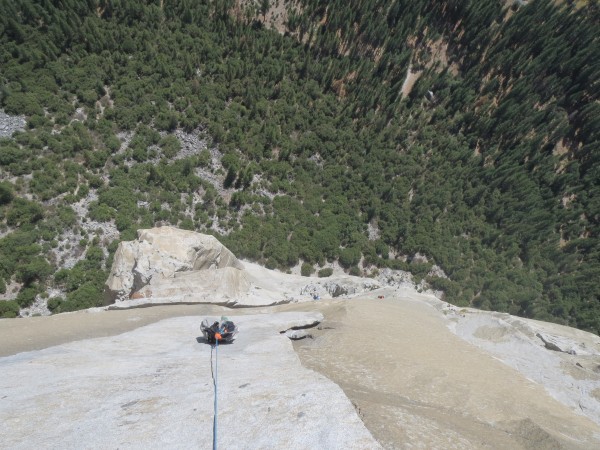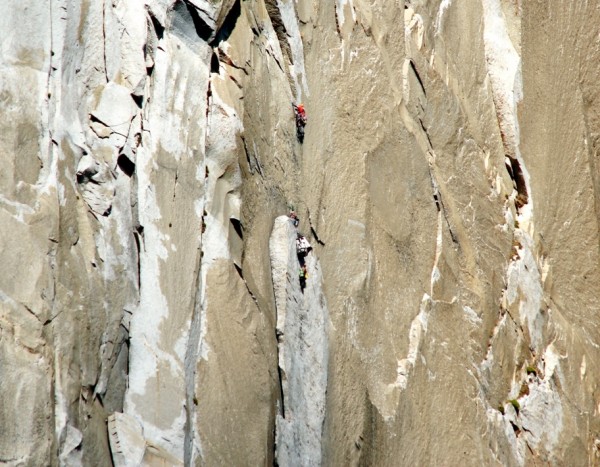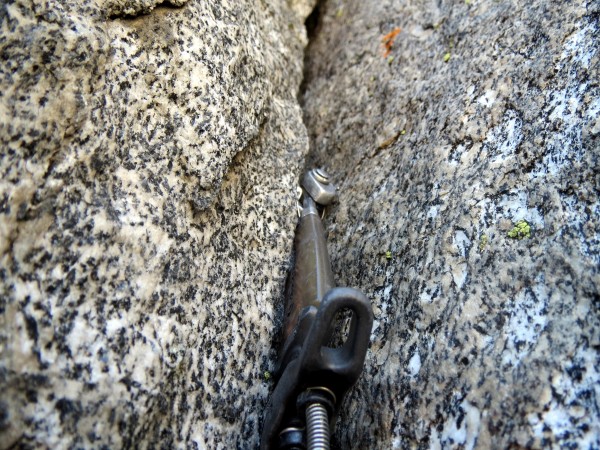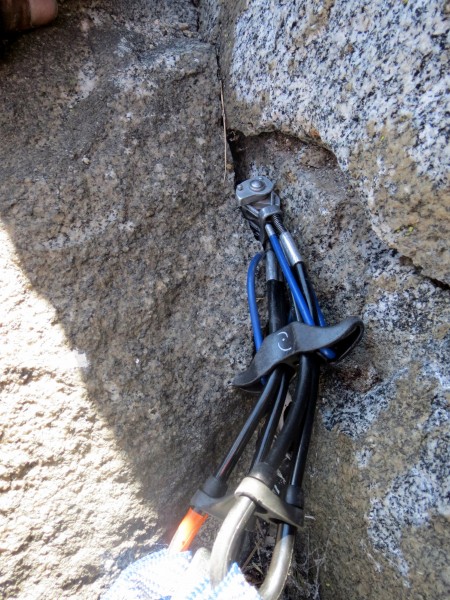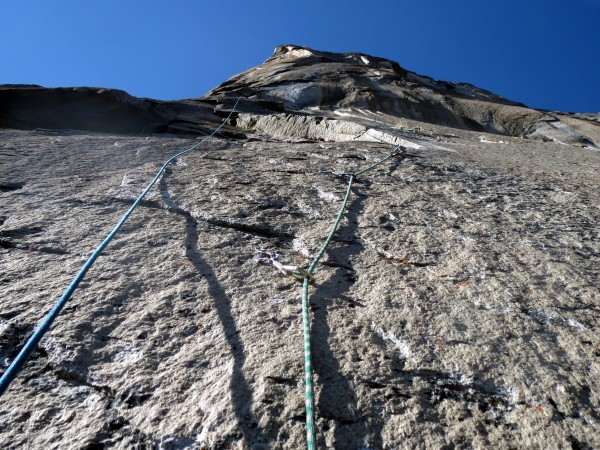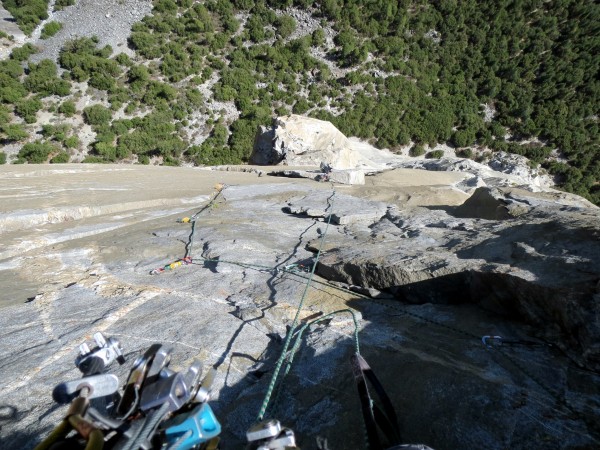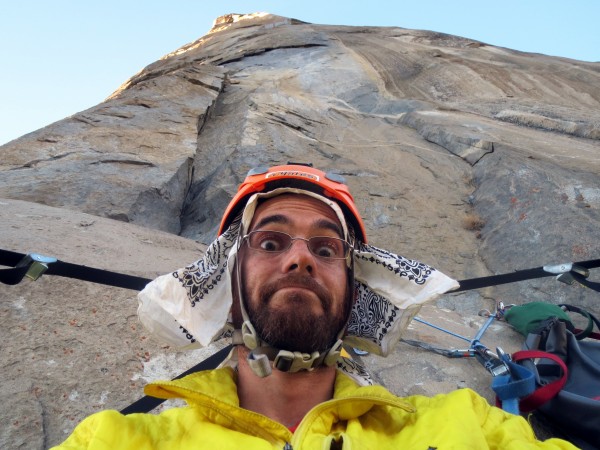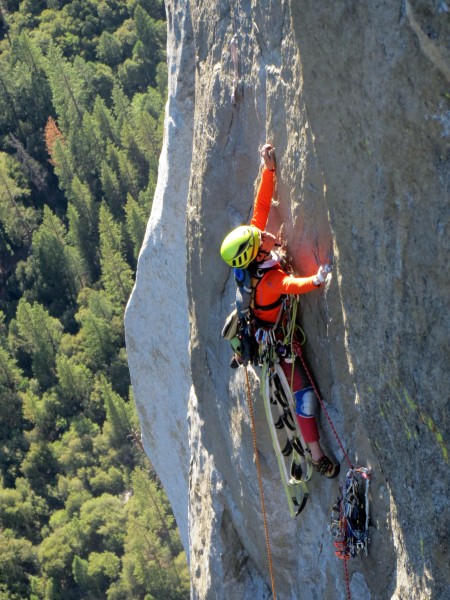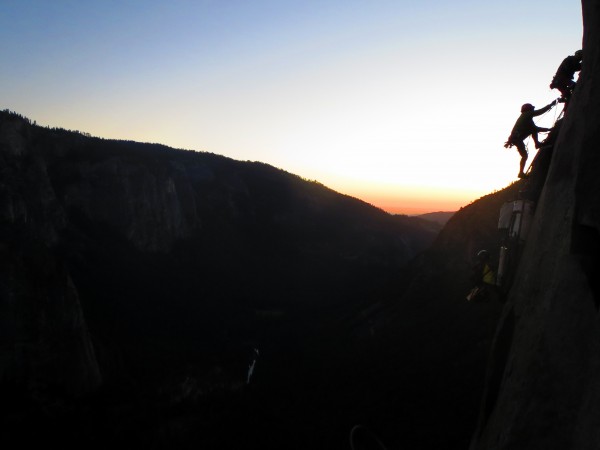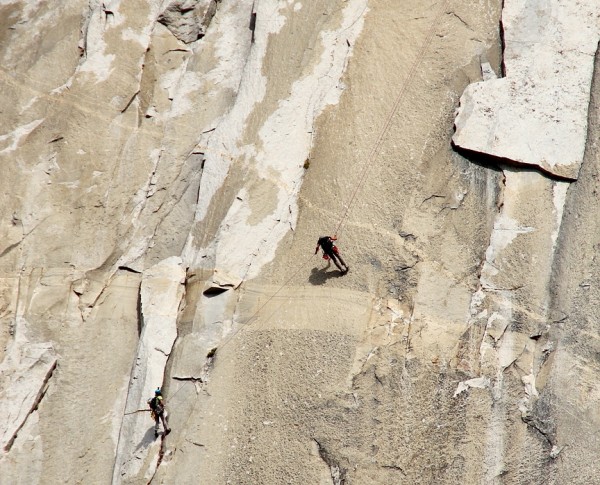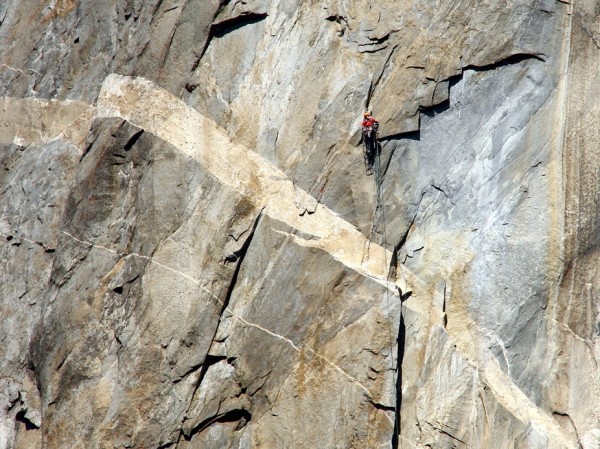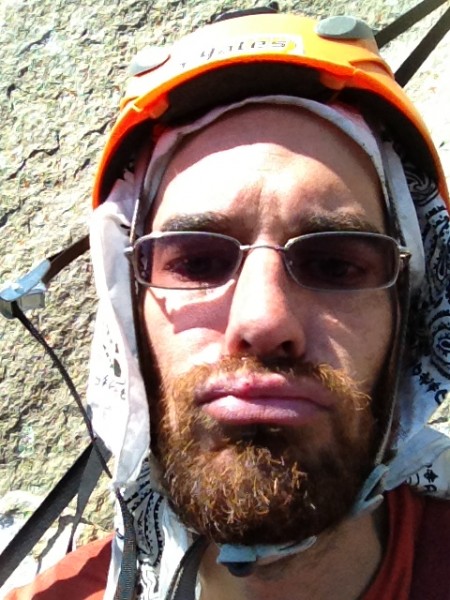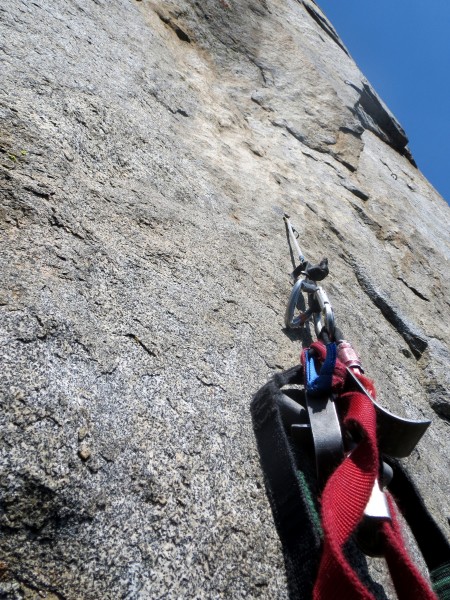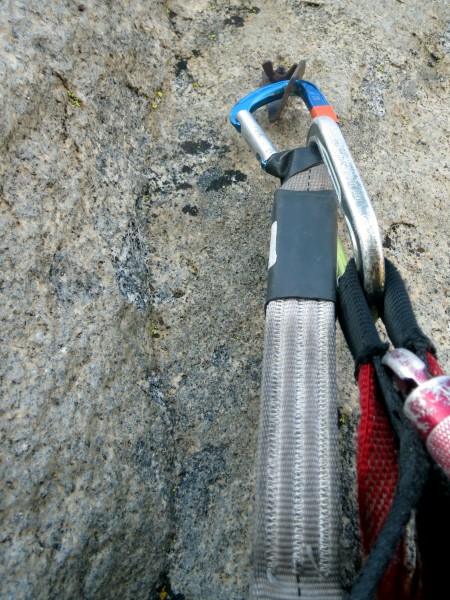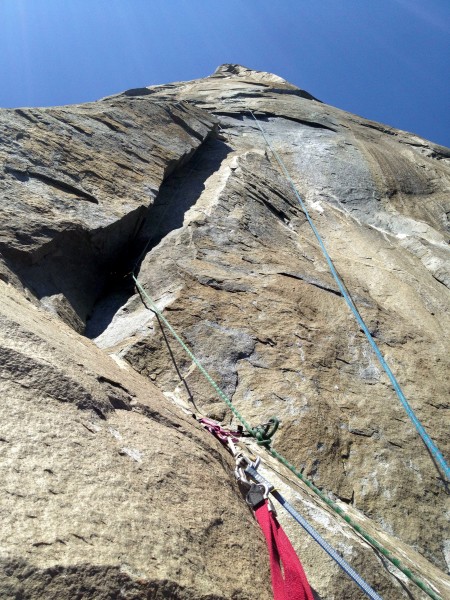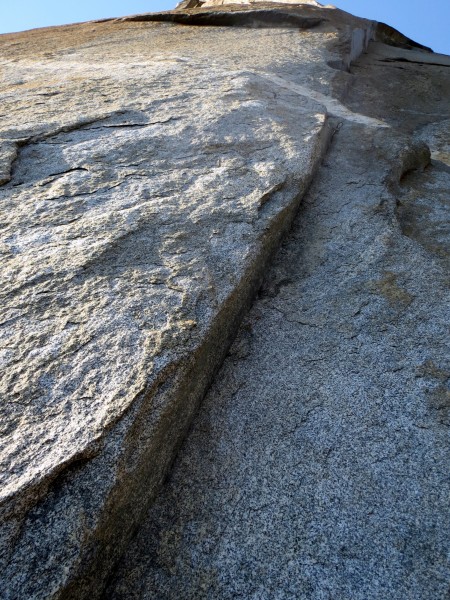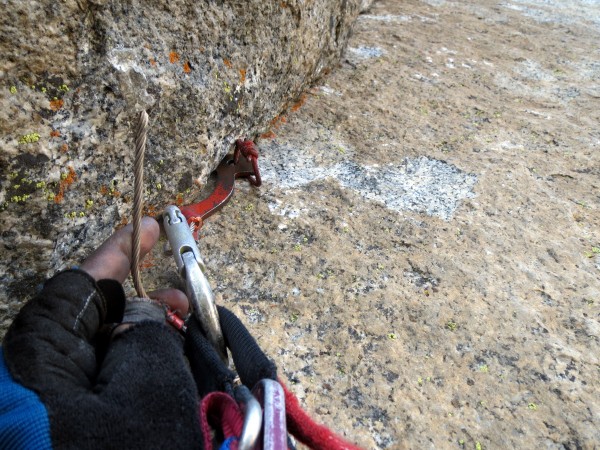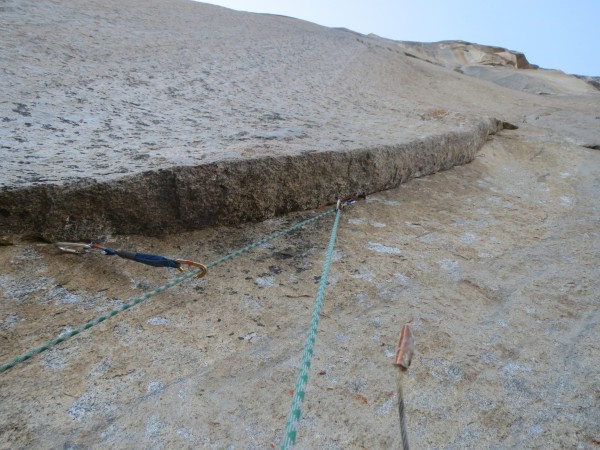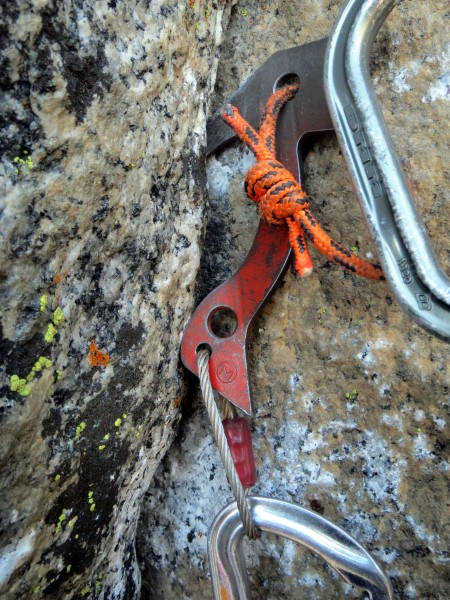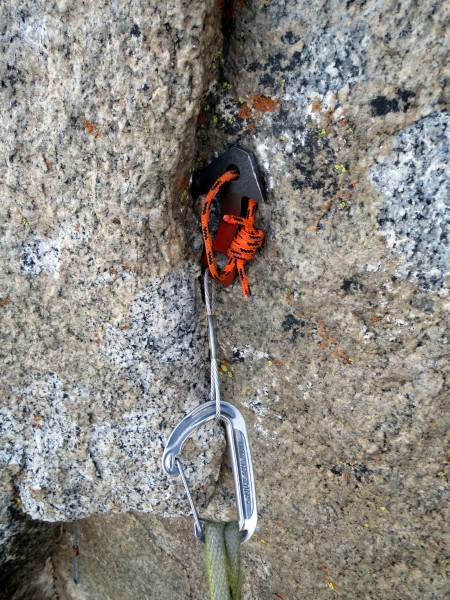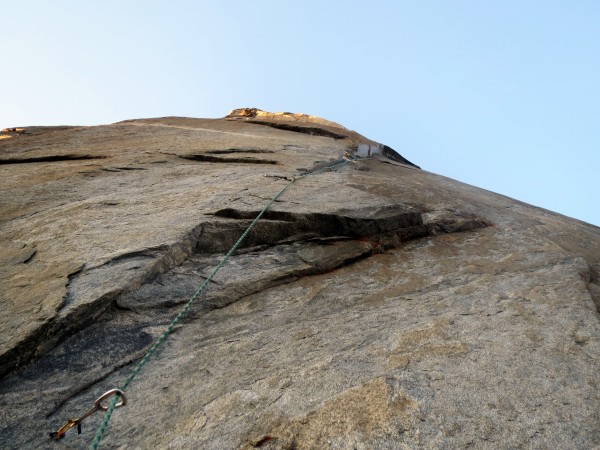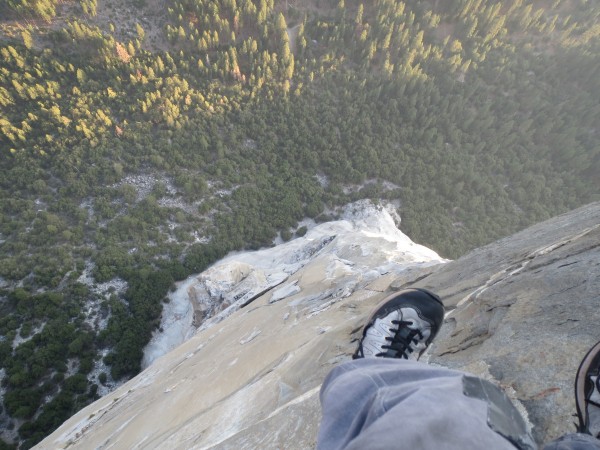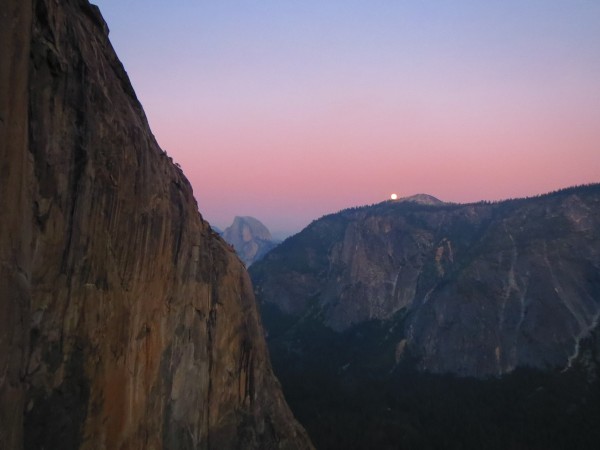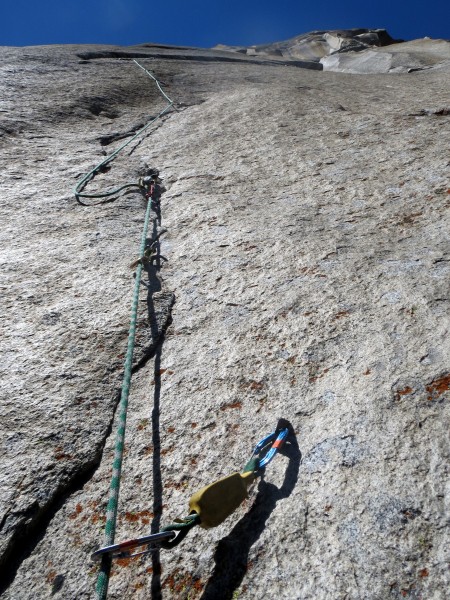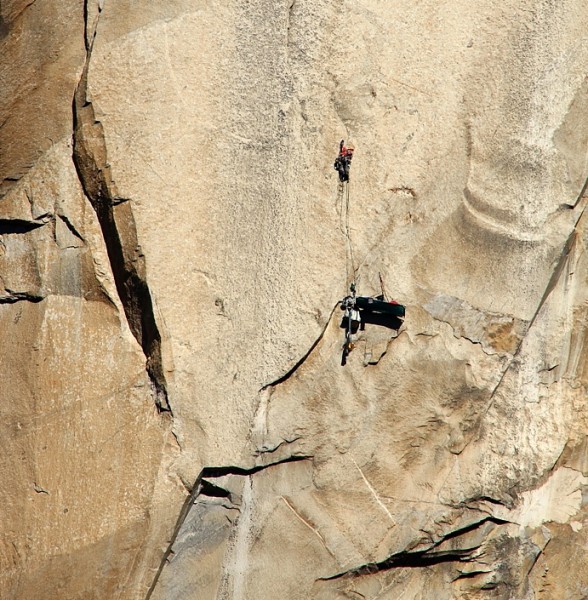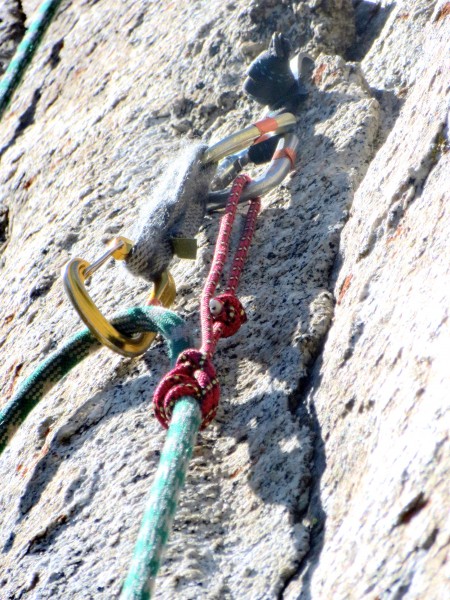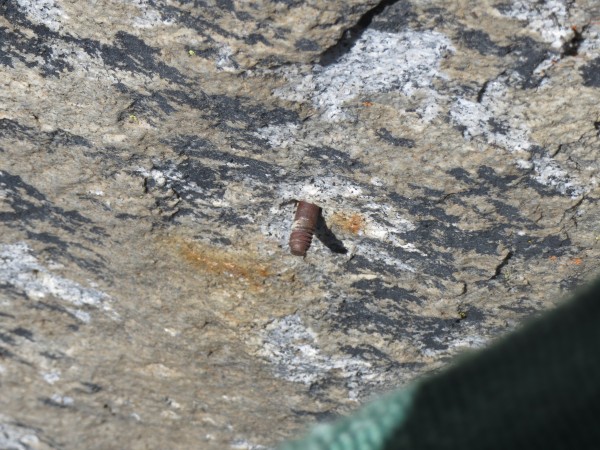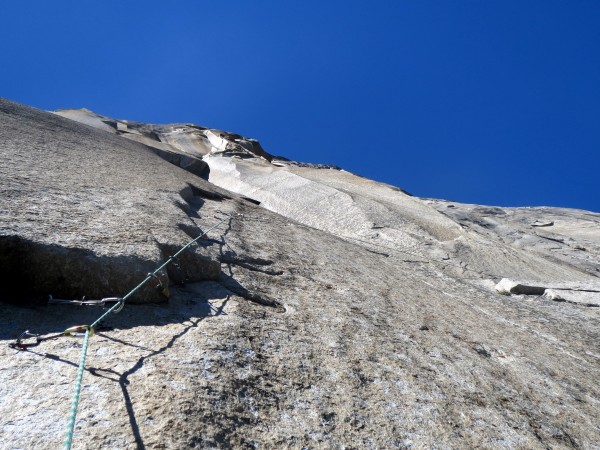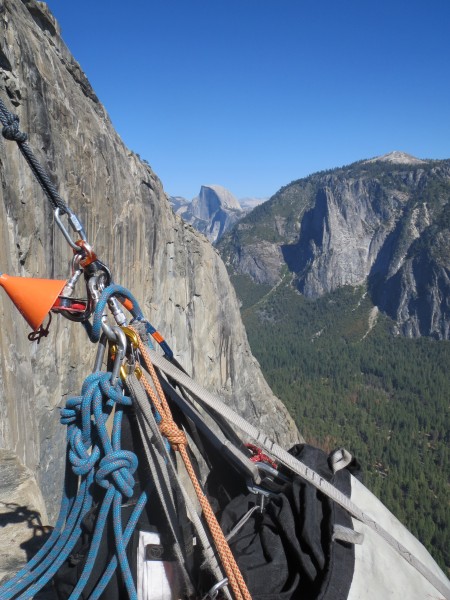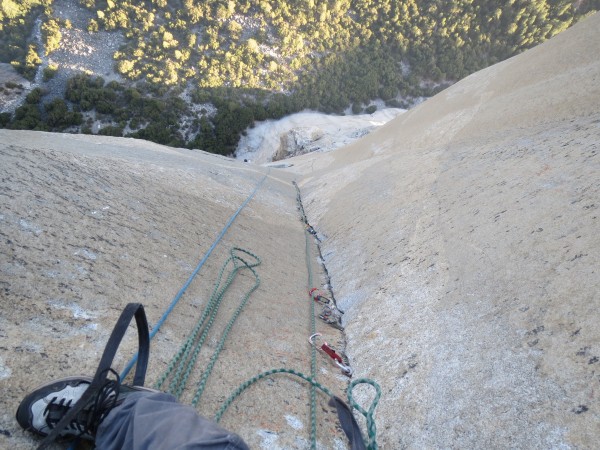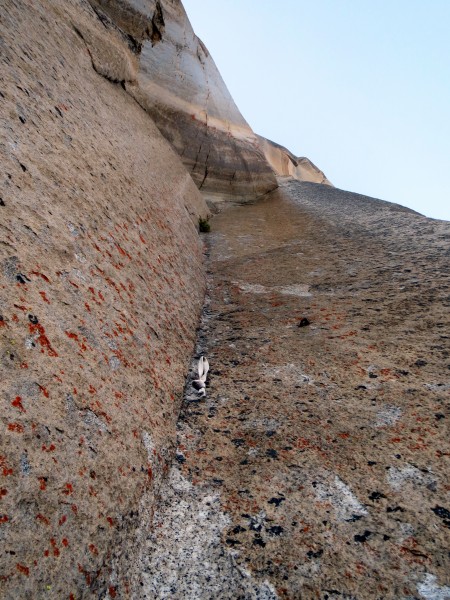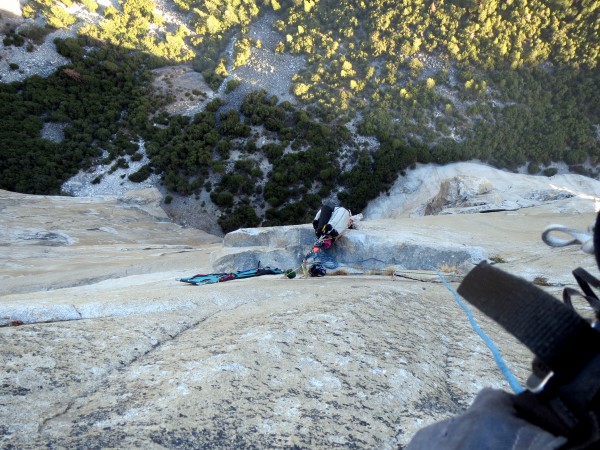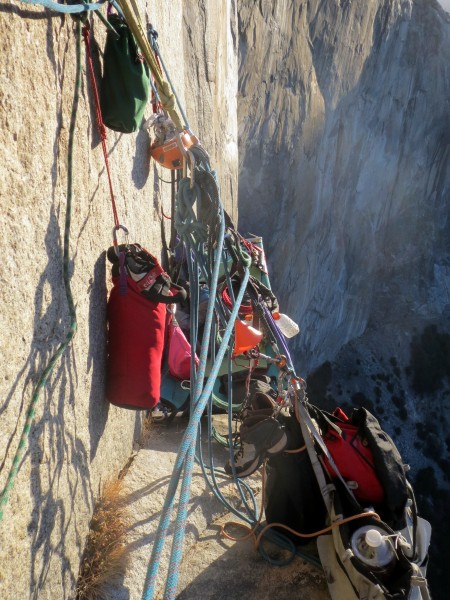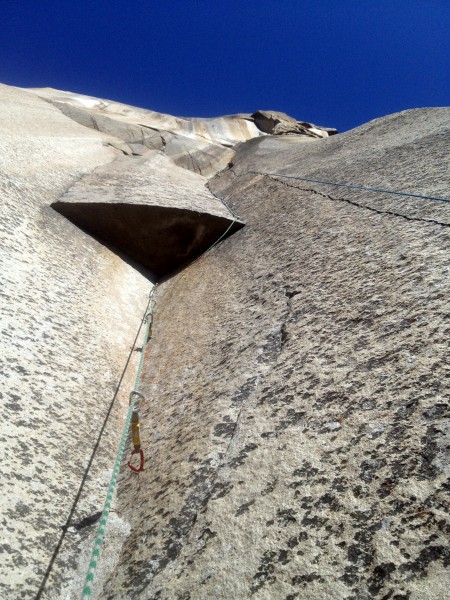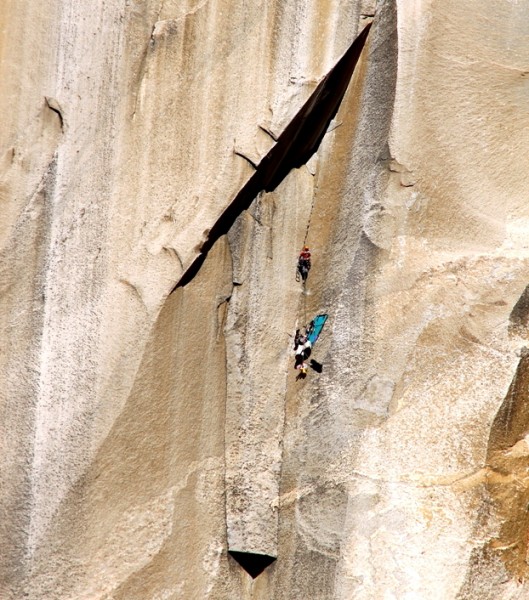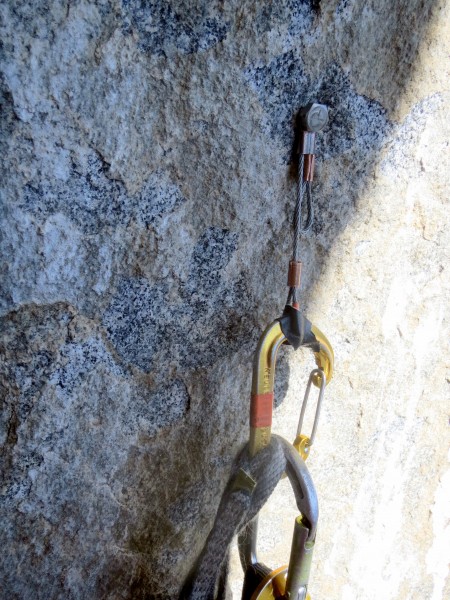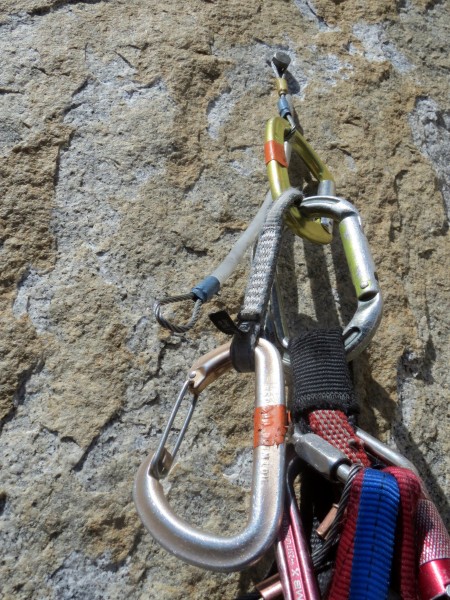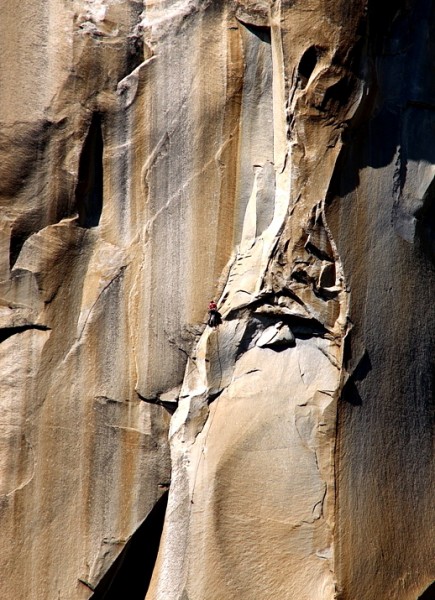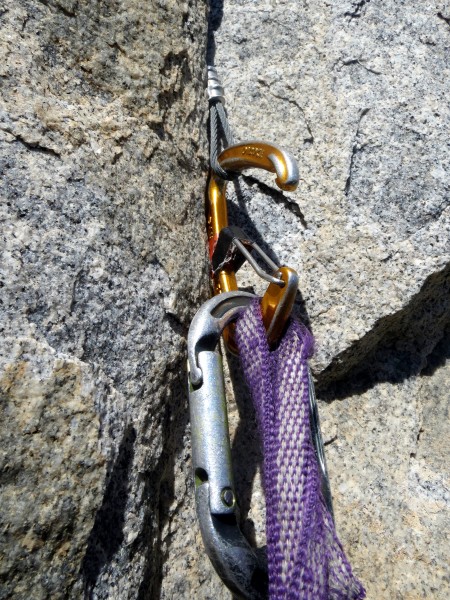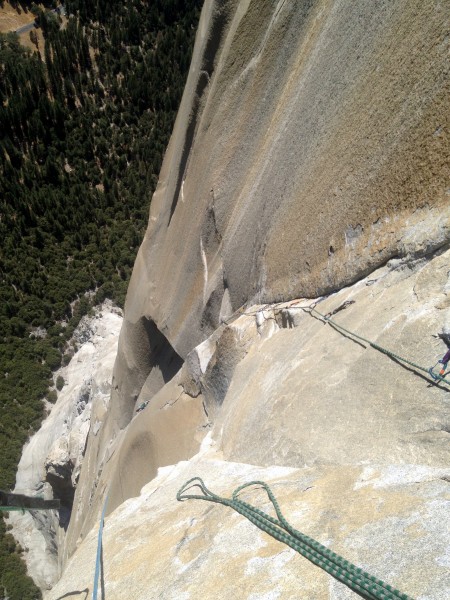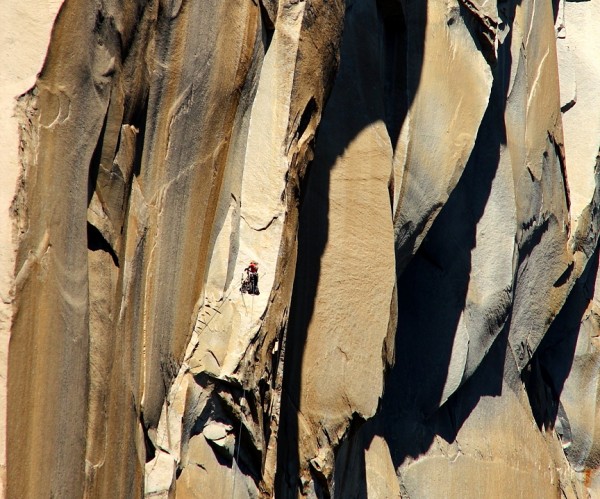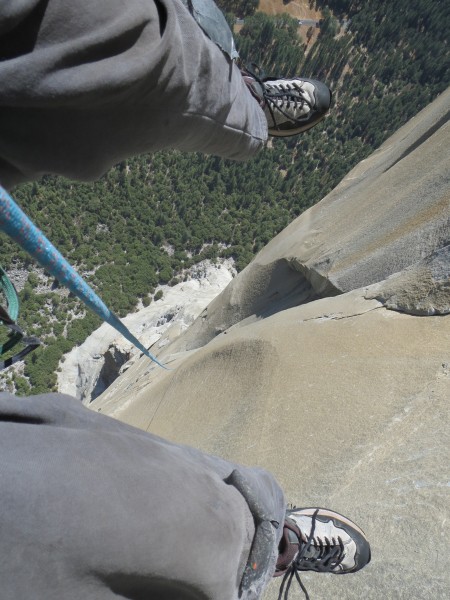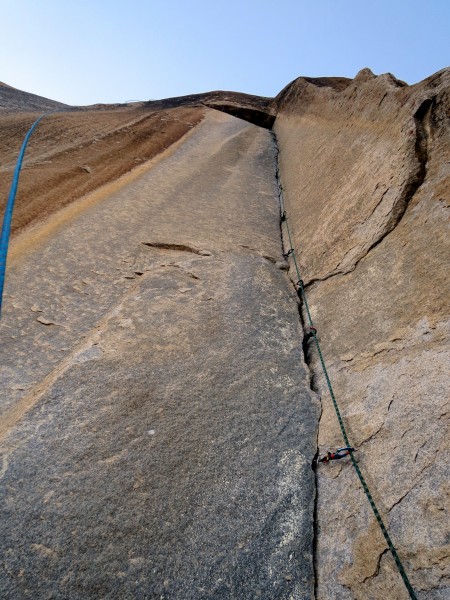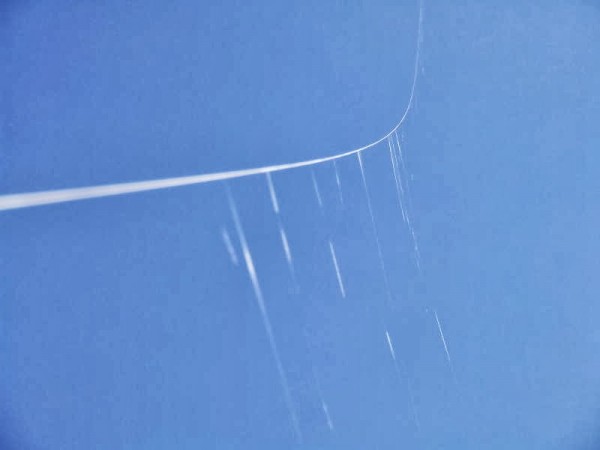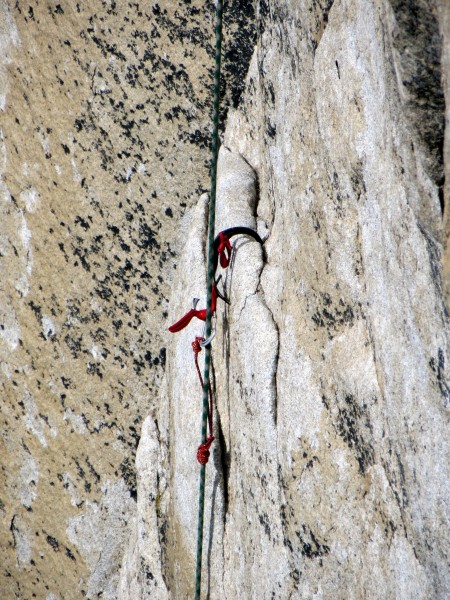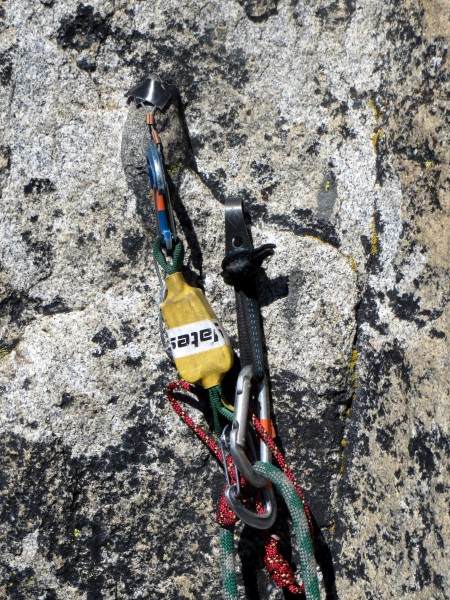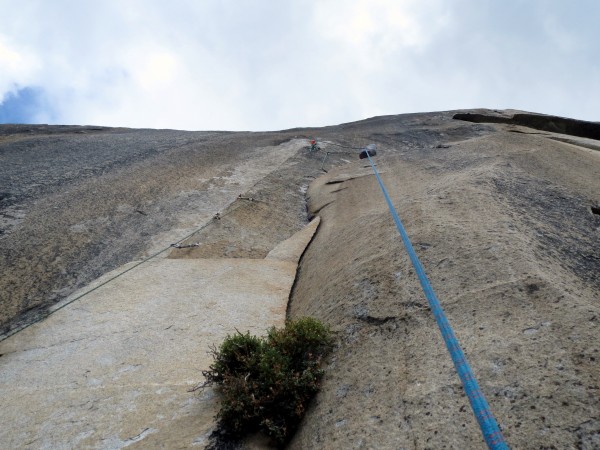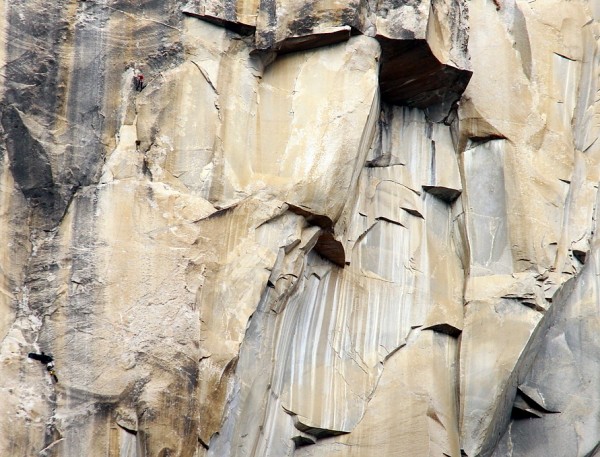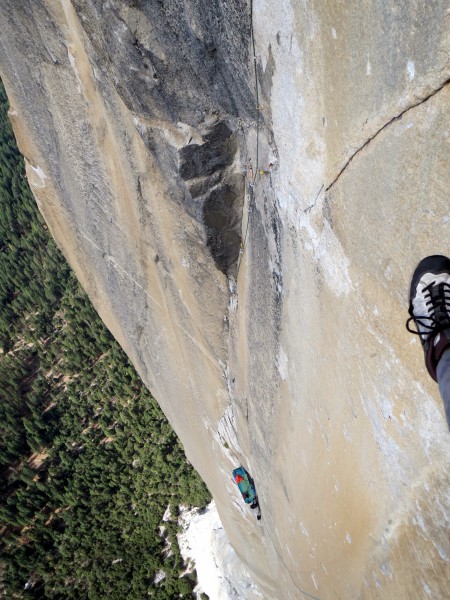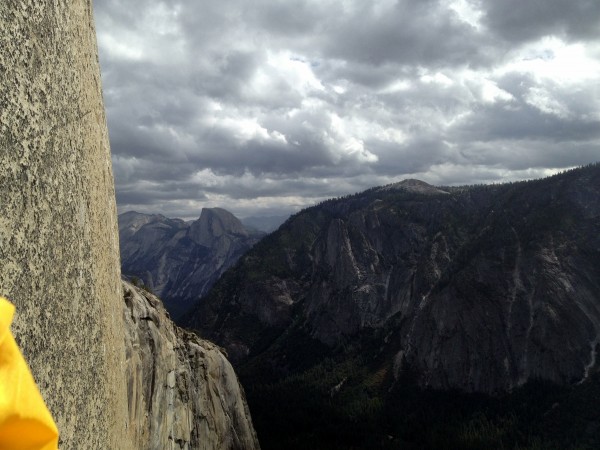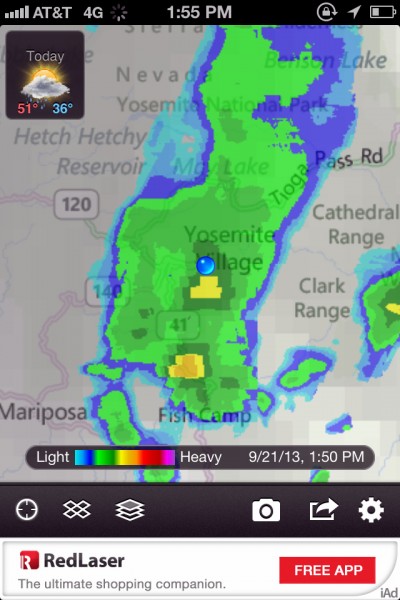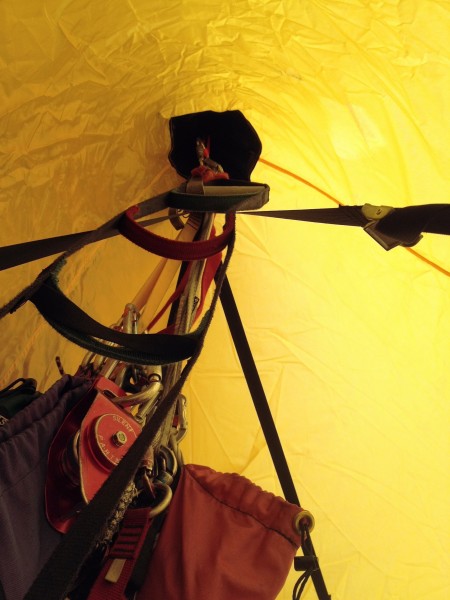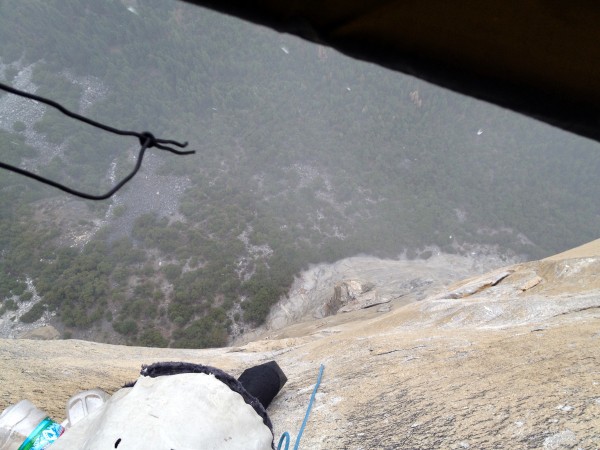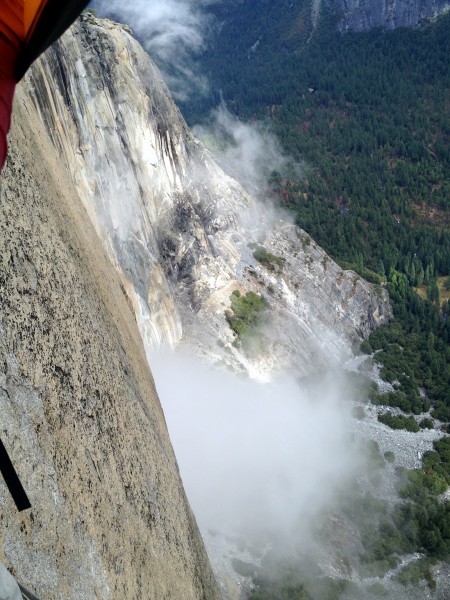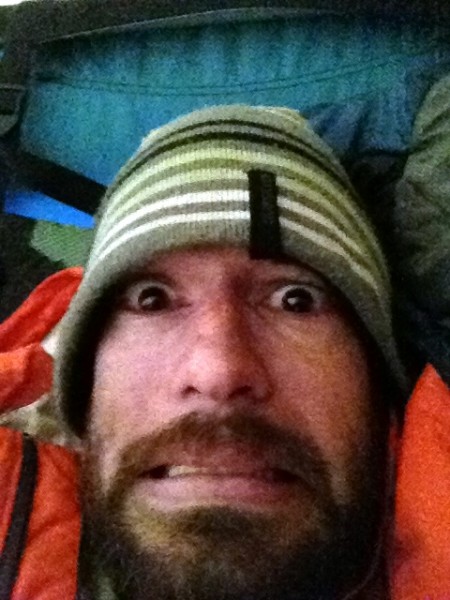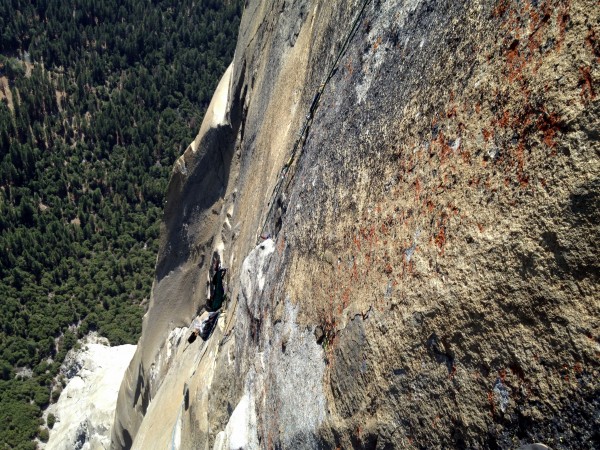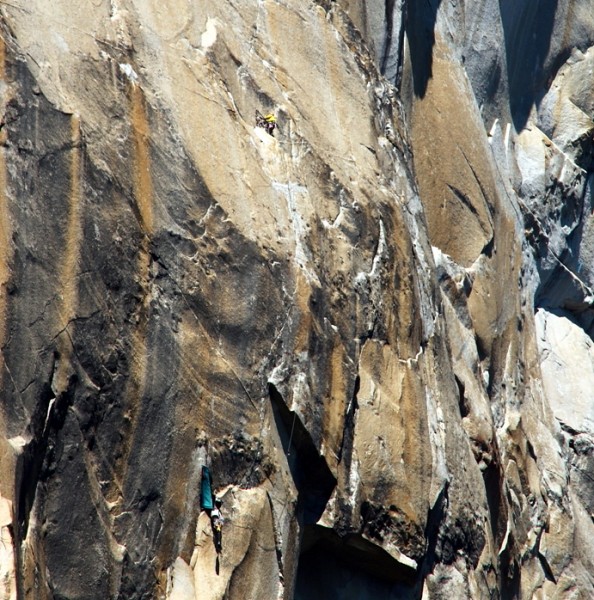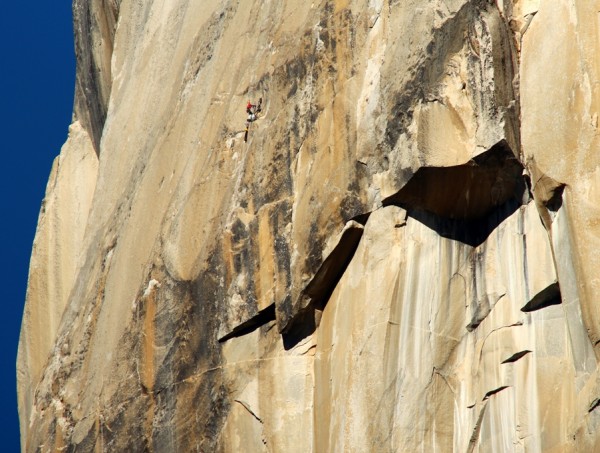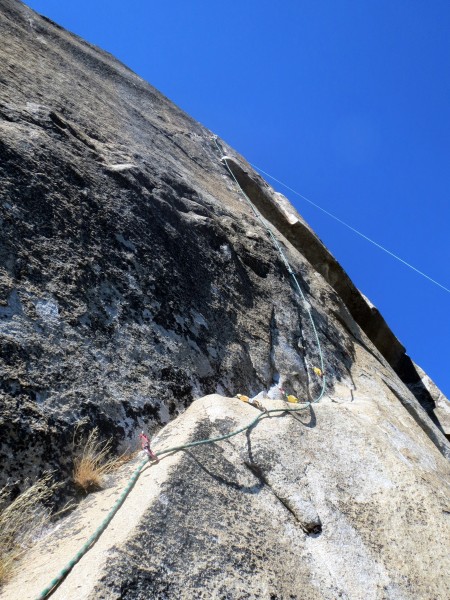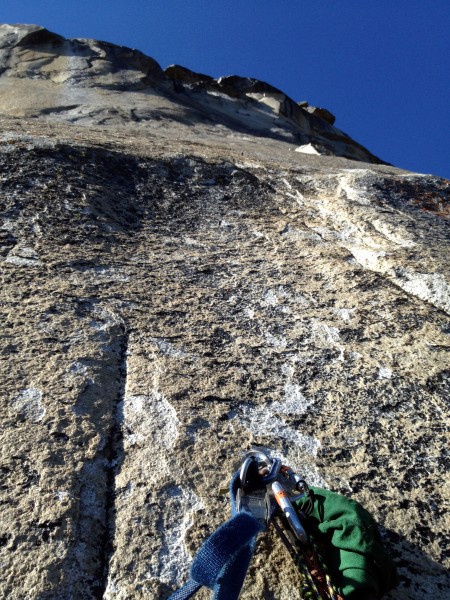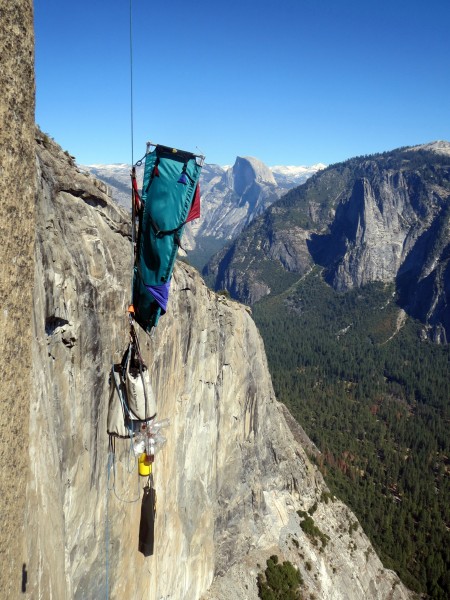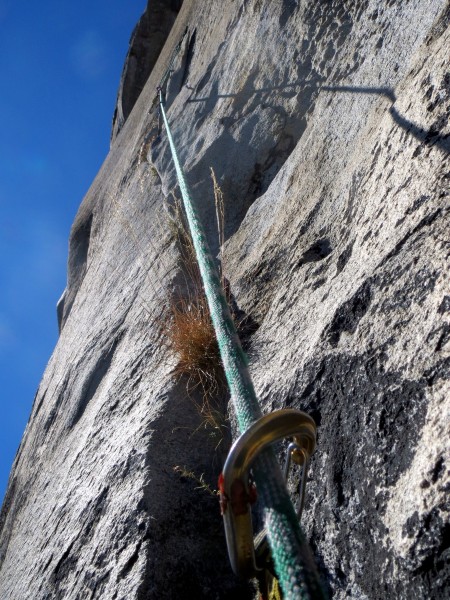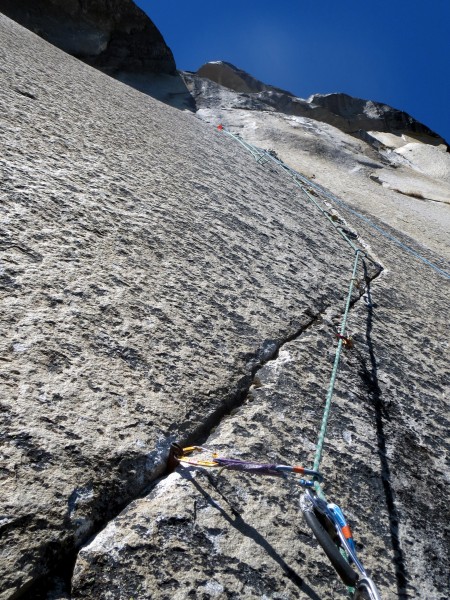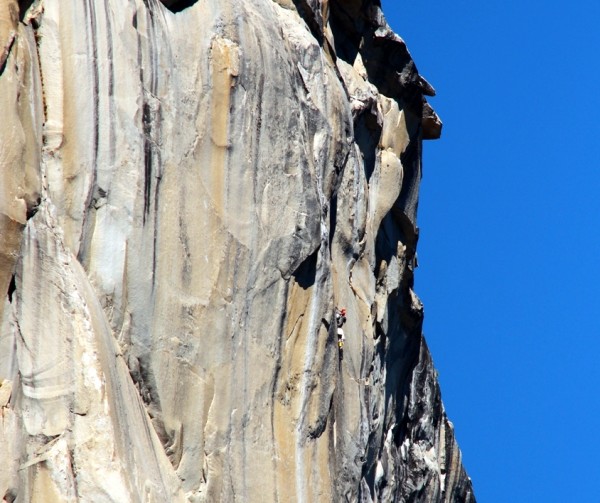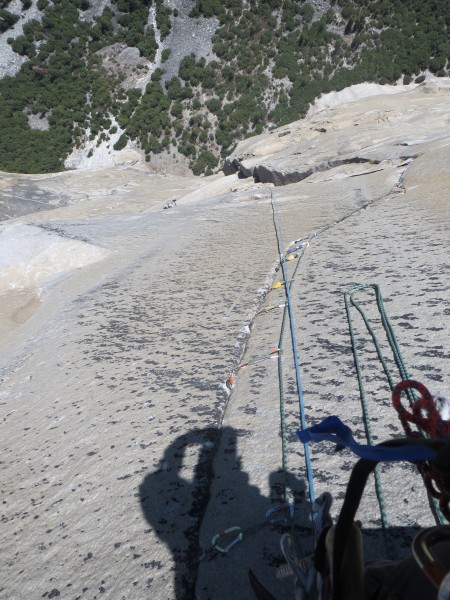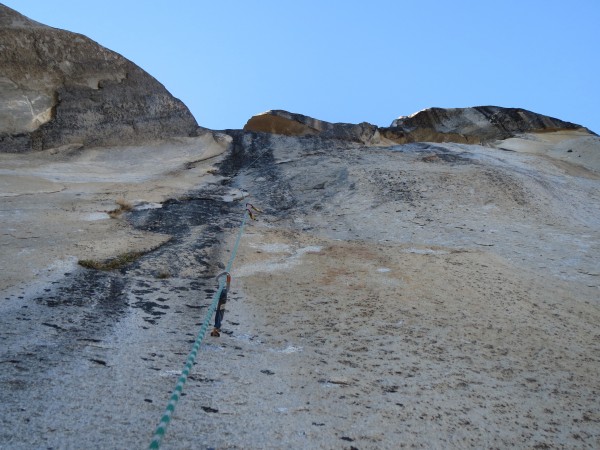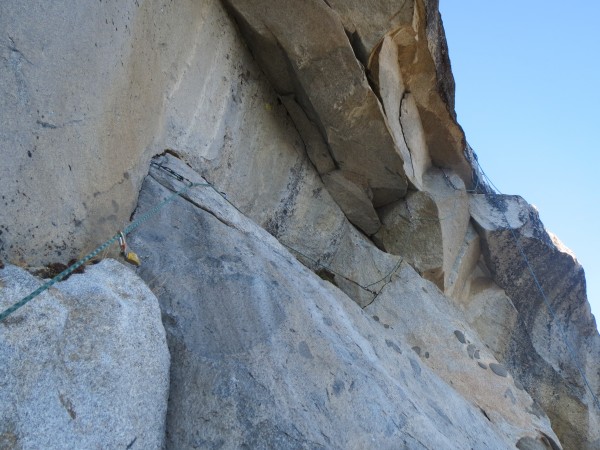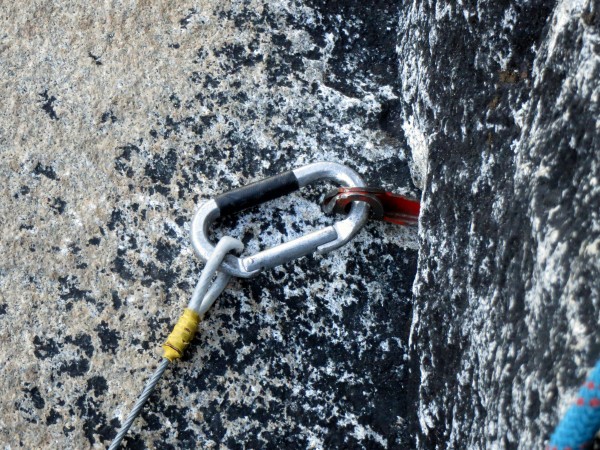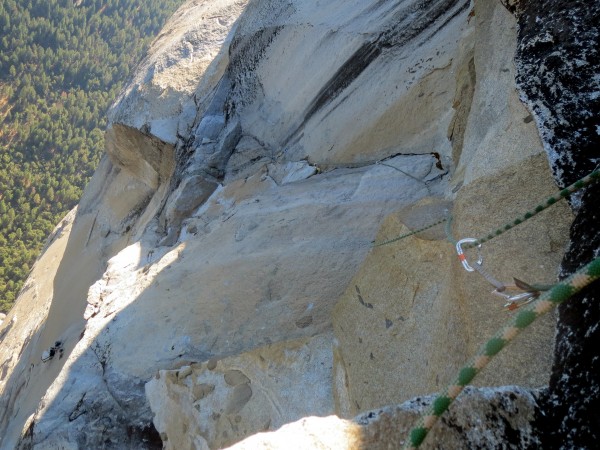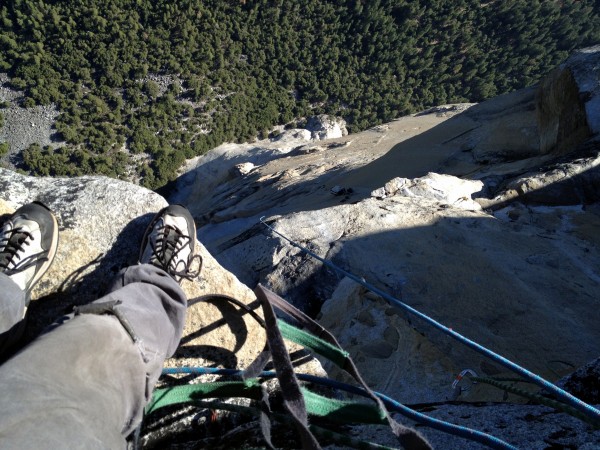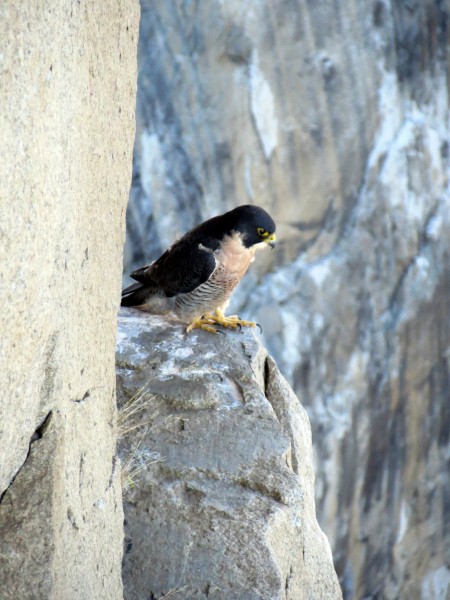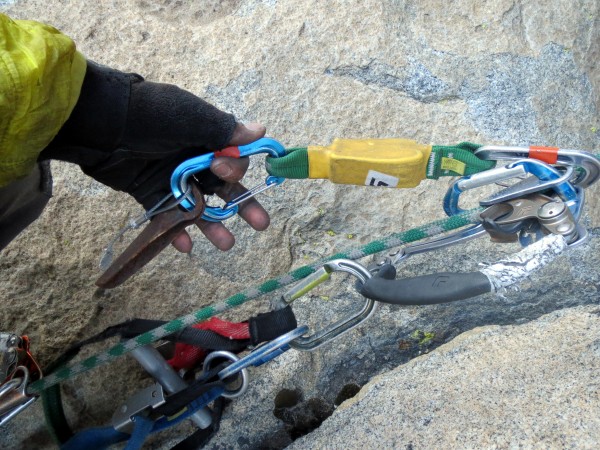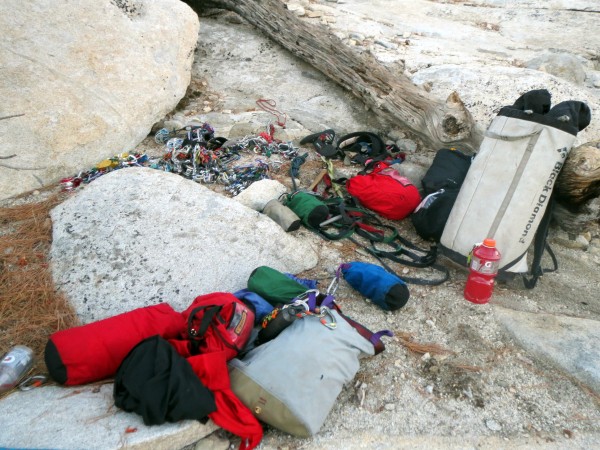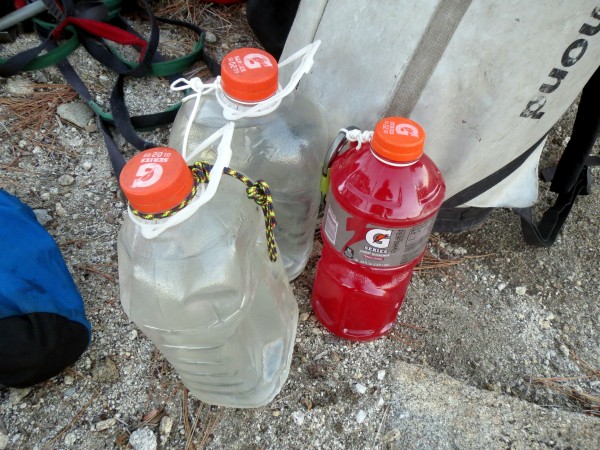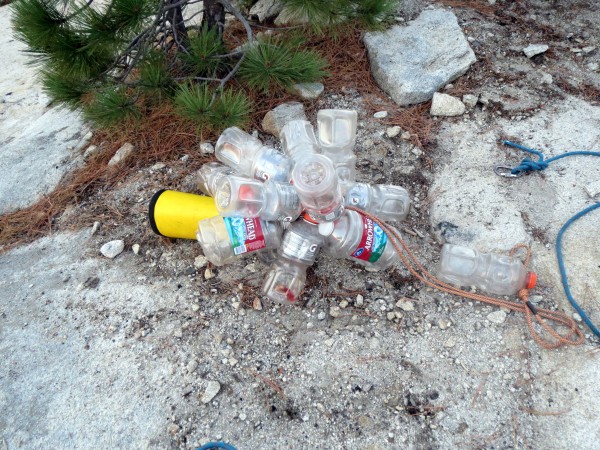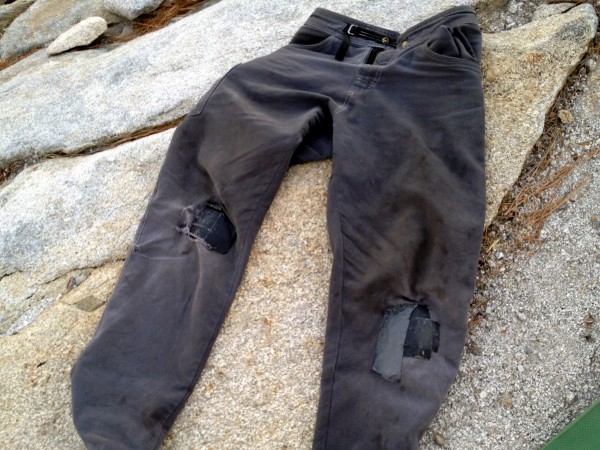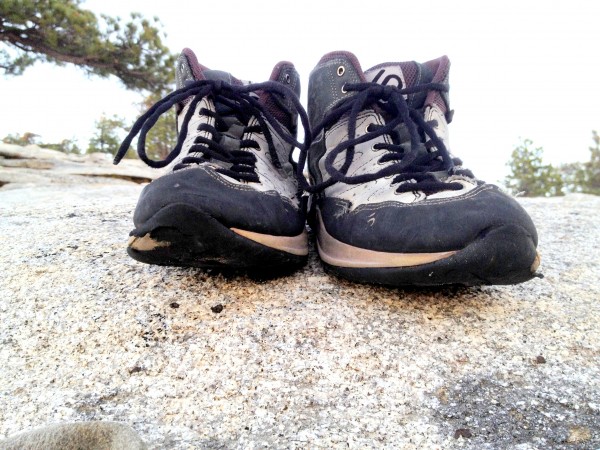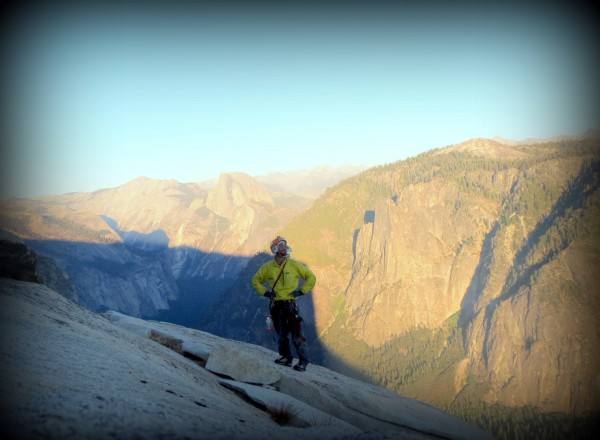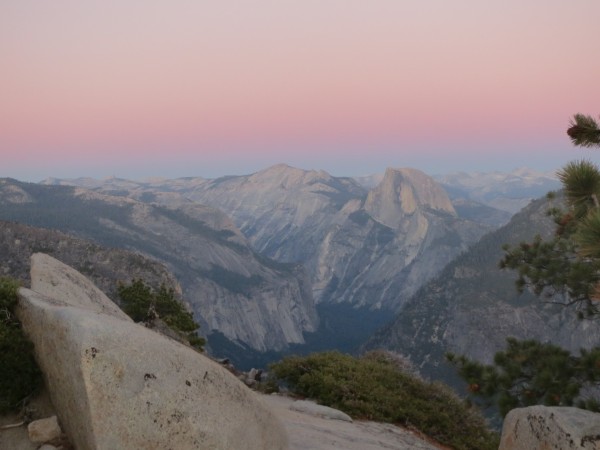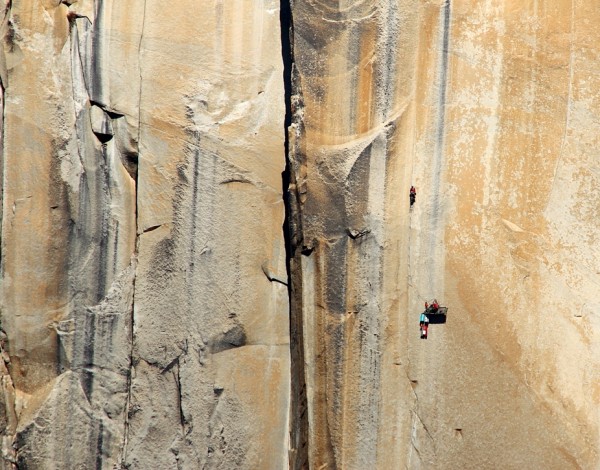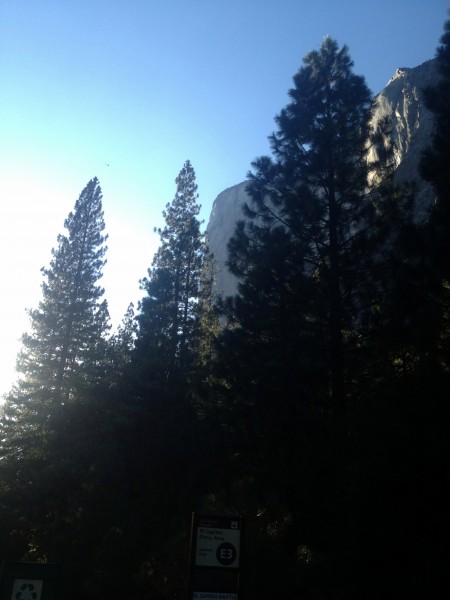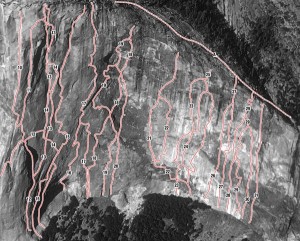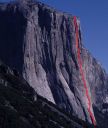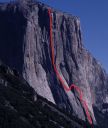Part 2 Tribal Rite
This is part 2 of my two-part Trip Report of my 12 day solo of Tribal Rite Via New Dawn. Please read part 1 first at the following link:http://www.supertopo.com/tr/Part-1-of-2-New-Dawn-to-Tribal-Rite-12-days-on-the-Wall/t12302n.html
Day 6 Tuesday Sept 17th (Bivy at 1)
In the morning it was time to climb The Boot and get onto that Tribal Lyfe. Most concerning to me was the multitude of Nose climbers that I watched rushing up the route, soon to collide headfirst into my slow soloing self. Knowing Tom was down at the bridge, the last thing I wanted was to be called out for slowing down The Nose expressway. I figured that if I had trouble, then no problem, slow it would be, but otherwise it was my responsibility to the other climbers to make sure I was going as fast as possible. I’ve had to bail off more than one route because of plodding parties in front of me to not try my best to get out of the way.
Once I had my kit hauled to the top of Texas Flake I set out to see how well The Boot would fit me. Turns out that it fit rather well. Quickly moving through the bolts to The Boot I was able to topstep easily by liebacking the edge of the crack of The Boot, placing offset cams like C1 butter and camhooking to fill the rest of the time. For someone that doesn’t freeclimb when there’s an aider within arm’s reach, I felt good about finishing the pitch in about 30 minutes before heading back down to clean and haul to the belay on top of The Boot. I spent extra time to hang my bags below the top of Booth so that any parties that came after me might be able to better move around them but throughout the day I watched as the four parties below me either bailed or took the Jardine Chisel Job instead of the swing.
I only believe in good signs and noticed immediately that once I was standing on top of The Boot that there was no longer the stench of urine surrounding me like a nighttime succubus. I couldn’t think of a better way to start Tribal Rite.
Soon enough I was on Tribal Rite’s first pitch and loving it. These were some of the reachiest rivets I’ve had to deal with yet. I found myself top stepping and yet still needing to reach almost beyond my fingertips to make my placements work.
I was lucky to find beta online before starting the climb that the “x” on the topo that connects the first two features was a bathook hole, thus saving me a lot of time as even with this knowledge, the bathook was easy to miss. Have I mentioned that I hate hanging out on bathooks? Well, I hate hanging out on bathooks. This is mostly because I never feel secure on them compared to a hook on a normal edge.
From the bathook I found that I was going to be forced to make a blind placement because I couldn’t reach my body far enough to the right to get a good look without destabilizing the hook. I tried a bunch of different pieces, all of which would hold just long enough to pop on a real bounce test attempt, leaving me off-balance, almost-falling, and watching the tip of the talon hook twist ever-so-slightly in the worn hole. Finally I got a yellow/orange Metolius offset to stick into… something out of sight and decided to trust it once it survived my half-assed leg-kick bounce testing. Once I dropped out onto it I saw that it was badly cammed and marginal at best. I was able to quickly place a camhook allowing me to reset the cam into a bomber placement.
After this, the topo said “many micronuts” but I found that with camhooks, I didn’t need to place many (if any) at all. Instead, I’d say get comfortable in your camhooks, because you’ll spend a lot of time on them. At one point, a two-lobe blue totem placement and later, a two-ish lobe Bdel C3 placement saved me from having to do anything silly. Towards the top of the pitch, the topo said to “move left,” but I found the climbing continuing up the main crack to be easy and looked much more inviting than moving left.
I was beginning to get concerned with my mental state. I’d seemed to have reached a point of equilibrium with the wall and felt as though I was where I belonged. This realization came to me soon after I stopped midpitch and began laughing uncontrollably over nothing. If anything, the immensity of my surroundings clashed with the minute level of my 10’ attention span. Later, Mungeclimber would comment on my laughter as, “All externalities have been shed. Laughter as the natural state has taken over. The Wall is good.” I’d have to agree.
The belay was a bolt on a slab with a vertical C1 crack for gear. Overall there were a total of two fixed pieces on the entire pitch, both of which were easily bypassed so even though the topo rated the pitch at C3F, I’d consider it to be a creative C2+.
Once I’d finished cleaning and hauling the pitch I was toast and done for the day. With the next pitch having “A3+hooking” on the topo, I wasn’t about to try tackling that in the dark. I set up shop at the top of pitch 1, happy that this would be the last time I’d need to setup my portaledge for the climb as I intended to flag it the rest of the way. Salami and sweets soon followed.
I soon found my new Tribal Rite pastime: watching climbers on The Nose. This day found a crew of Korean climbers with their leader freeclimbing pitch 18 of The Nose. He was tenacious and kept at the sections that gave him trouble over and over until he got it. As the sun began setting, their entire team was just getting to the belay and I was able to get great shots of them hauling their kit as a team in silhouette. As I watched them, I couldn’t understand anything they were saying, but I definitely feel like I can recognize Korean curse words now.
Day 7 Wednesday Sept 18th (Bivy at 3)
I woke up excited to face the first A3/A4 of the route in pitch 2 of Tribal Rite. Above my belay was a long flared chimney that looked like it would be a nice respite from the heat that was surely coming my way later in the day. Looking down from my portaledge vantage point I realized that I had a view of the King Swing that not many had. I reminded myself that I was here to enjoy myself and so for the next few days I “slept in” by sitting in my ledge and waiting for the teams, that inevitably started well earlier than I, do the King Swing. From my belay, right over The Boot, you get a foreshortened view that makes the swing look shorter than it is, but your proximity to the climbers makes their effort and decision making feel right in your face.
King Swing videos taken from Tribal Rite 9/18/13
[Click to View YouTube Video]
[Click to View YouTube Video]
Here’s Tom’s photo of the same team after completing the swing
After my morning entertainment, I started up the awkward flare that really wasn’t so bad except for a loose flake deep inside the flare that caused me to work a little bit harder than normal to get through the feature.
After the flare and a “loose” section that wasn’t so bad, I reached a point on the topo that showed an “x” to get into a ramp with the A3/A4 climbing. Once I got to this point I was stymied by a lack of bolt, lack of rivet, lack of bathook hole, even the lack of a patched hole. I worried that I was somehow off route and spent a bit of time looking from as many directions as I could to find something on the topo that would qualify as an “x” placement but to no avail. It wasn’t needed though and two solid hooks led around the corner to a reachy camhook placement.
The next section was thoughtful and super fun with a hand-placed beak, plenty of interesting clean pieces and a cam-to-the-face that popped when bounce-testing just to keep me honest. The rivets were slightly overhanging and required a bit of gymnastics combined with the rivet extender that Mucci made me. We 5’short” guys got to stick together.
Overall, I was excited when I reached the anchors because the pitch had gone at a solid C2F for me. I was beginning to harbor high hopes of an all clean ascent, but those hopes would soon be dashed against the rock like so many of the needless heads I would soon encounter.
Soon the pitch was hauled and cleaned and it was off to pitch 3. The pitch started out as a disappointing string of fixed heads and rivets. Most disturbing was that during the rivets, climbers that had come before still felt the need to place a bunch of #1 heads to backup or “replace” the rivets that were already there. I guess this is the result of the constant “split-shaft ¼ inch bolts are soooo scary and need to be replaced because clipping one is basically signing your death warrant” hysteria I see everywhere but in the bigwall or alpine climbing sphere. I was trying to move quickly at this time and didn’t get any photos of the madness.
Soon the pitch turned and became fun once I pulled out a head with my hands and had to replace it. Did your hero place another head? Not when you can place a red Tomahawk! It was a good thing because the next head held just long enough for me to get to my third step before it blew.
The fall was one of those I-don’t–know-what’s-happening-right-now-oh-I’m-falling falls before my Silent Partner caught me. I looked up and was happy that the beak had caught me because I’m pretty sure the rest of the heads would have ripped if I’d fallen onto them instead. After a few moments to laugh and catch my breath, I jugged back up to my piece, placed a beak tip and kept on going. And just like that, in a few feet of climbing, my clean ascent and my no-fall ascent was gone. I wasn’t too worried about it though, and just wanted to finish the pitch.
Soon enough I hit the anchors and cleaned the pitch and hauled my kit to the anchors for the night. Later that night I was treated to the moon rising over Half Dome which at the time was beautiful. That beauty quickly gave way to cursing as the moon beat down on me throughout the night, keeping me awake whenever my beanie slipped back from covering my eyes.
Day 8 Thursday Sept 19th (Bivy at 4)
While I was watching climbers on The Nose in the morning I noticed a team of three climbers making their way to El Cap Tower. As I watched, their third somehow dropped one of their puddled ropes. They didn’t notice at first and I watched as the rope slid down the slabs making it all the way to the deck. The team ended up hanging out on the ledge for most of the morning before bailing. Even from where I was, the dynamic between the leader and the third on the ledge was obvious and frosty as best. There are certainly some benefits to soloing.
Nose Team that Bailed 9/18/13.
[Click to View YouTube Video]
Pitch 4 looks like a rivet highway on the topo but took a little bit longer than I anticipated due to dealing with a sketchy hook placement right off the belay and then one of the rivets being a bit mangled and needing to use a Fish Doubloon to make it work.
The highlight of the pitch was a pendulum to the ledge that was very long and super fun. As I was running sideways along the rock, perpendicular to the wall, I felt like I was on my own personal King Swing. It took me a few tries because I had to lower myself more and more. I misjudged the distances at first because I really didn’t believe the penji was as long as it actually looked. More laughter escaped me. Reaching the ledge was made easier by a purple totem placement to protect the mantel onto the ledge itself.
Once I’d rapped back to the anchor to start cleaning my pitch, the wind started to kick up and I ended up having an epic wind-fight with my portaledge. I had learned a lot about flagging my ledge when I was soloing Afroman. I would be leading high above my kit and look down to see the ledge whipping all about like a dog trying to get rid of its fleas. I now knew to anchor my ledge down before setting off to lead a pitch. Now though, the wind was taking advantage of the few minutes between releasing the ledge from its tie-down slings and then attaching the corners of the ledge to the haul line for flagging.
More than once, the ledge would fly well above my head before crashing down on me again. It started to become comical and I hoped that there wasn’t a lens from the bridge trained on me with a befuddled tourists going, “Oh my, what… IS he doing?” I had long passed the point of deciding to just breakdown the ledge. This was a fight between my own stubbornness and Mother Nature’s naturalness.
I reflected for a moment, in-between desperate grabs for the ledge straps on my part and howling windy punch-him-in-the-face-with-his-own-ledge silliness on Mother Nature’s part, that the idiocy of my wanting to flag my ledge even though it wasn’t convenient wasn’t that much different from wanting to climb this huge stone even though it wasn’t easy or convenient. These are the illusions of grandeur that keep the soloist company.
[Click to View YouTube Video]
(This video is actually from pitch 9 but made more sense to post it here in the TR)
Soon I got my ledge and bags released from the anchor and made my way up to the fantastic ledge at the end of pitch 4. This ledge was by far one of my favorites on Tribal Rite. Long and flat, with seven bolts and an extra rivet for good measure, I was able to set the portaledge up and sort through my bags to make the upcoming days go a bit smoother. By now I was thinking that Hudon would be proud of me, as I had caught most of my urine in my empty water bottles. This is something that was not too hard to do and the return on investment paid off well in my feelings of not disregarding the experience of the climbers on The Nose below me.
View from the Portaledge, Pitch 4, Tribal Rite
[Click to View YouTube Video]
As I looked up at The Carrot from my vantage point on the belay ledge, I began to really feel the exhaustion setting in. I considered taking some Advil but decided that it would sit better at night when I normally take my daily vitaminprofen with food. Instead, I rested for a bit to let the sun pass by. I knew that I was only going to do one more pitch because the ledge I was on was definitely where I would bivy, so resting made sense. After all, I kept hearing Mucci’s voice in my head giving my favorite bigwall advice, “slow down, enjoy yourself.”
Soon it was time for The Carrot. I was worried because of what I’d read about the expanding nature of the feature. I wanted to climb as clean as possible and decided that I wouldn’t use the piton-at-the-base-of-the-feature technique for opening the feature up. To overcome this I planned on camhooking and nutting as much as possible and then cleaning on rap any cams I placed so they wouldn’t get crushed during the normal bottom-up cleaning.
Once at the base of The Carrot, I camhooked out of the little roof it creates. The fall would be clean so I continued to camhook up the feature, every now and then dropping a nut or an offset cam into the crack to protect me. Before I knew it, I was close to the anchors with only a few more moves to make when the clean placements ran out. I looked and searched the best I could before putting in a shallow SMC angle. Once I was on the SMC though, I was able to see that I’d missed a hidden brassy placement just above the angle. I let the disappointment wash over me for a bit before replacing that feeling with the elation of clipping the anchors.
The lower half of The Carrot (the feature is split in the middle by a belay) is an awesome climb. Using camhooks primarily made the feature not expand at all and so that part was never an issue for me. Medium and wide camhooks should be considered required gear on any trade route on El Cap since they’re much more solid than micro gear placements and you can always place a piece for psychological pro after you’ve passed the camhook placement if the I-don’t-want-to-fall willies gets to you.
Once I’d fixed the pitch, I rapped back to my ledge, removing all of my cams from The Carrot just in case as I went down. Back at the ledge I set up shop and took inventory of my water and food. Food was good for many days and with 4.5 gallons of water, I could do two pitches a day for the rest of the climb and still be good to the summit. Things were looking great as I took in the sights and marveled at the exposure of staring straight down the buttress of The Nose from the vantage point of my portaledge.
[Click to View YouTube Video]
Day 9 Friday Sept 20th (Bivy at 7)
In the morning I was looking forward to the next pitch because the topo had it marked as “awkward nuts and angles” and “sawed and stacked angles.” Having never needed to stack pitons before I was excited about the prospect. I imagined myself as the climber in the stories I’d heard from others that had climbed long ago where they talked about nesting pins in ridiculous placements. This was one of the reasons I chose Tribal Rite, to try to reach back to the past where the lack of “high tech” clean gear required you to be inventive with what you had.
Once I’d cleaned the lower half of the Carrot, I set off onto Pitch 6. The pitch was long and steep, clocking in at 160’ and requiring quite a bit of adjustable daisy humping to make upward progress without wasting too much energy. I discovered a bunch of fun usages for duct tape to make my reach go just that much farther. I was beginning to worry about running out of duct tape before hitting the summit and decided that my roll of tape would be longer on climbs from now on. From extending clips, to fixing portaledges, to sealing water bottles, etc, duct tape became the VIP of pitch 6.
What didn’t happen on the pitch was the need for angles in the first part as the topo said. Instead I found a hollow crack that accepted clean gear much more readily than pounded chunks of iron. Later in the pitch, I couldn’t find any situation where I would use stacked angles. I spent a bit of time looking for stacked angle placements in the latter half of the pitch just so I could make it happen but I never reached a point where a clean option wasn’t obvious so my z-tons remained lonely and unused on the back of my rack.
I realized when I hit the anchors that I hadn’t been denied the opportunity to be inventive with my placements, just that I didn’t have the need to be inventive in the “old” piton-based way. Instead, invention came from upside down inverted offset cams, funky nut placements, and duct tape to reach past seemingly blank sections.
I guess the measure of invention is not only defined by the climb, but by the context of the time you climb it. No less invention was needed for these sections, just a new kind of invention that still gives you the feeling of putting it out there at the limit of what your gear can do, but without the damage to the rock that comes from piton invention. This was an interesting realization for me, that looking back to the methods of the past may be important, but you can never deny the abilities of the present. Like appreciating Black Sabbath for their inventiveness that led to heavy metal but choosing to listen to Children of Bodom because the newer techniques and gear in today’s heavy metal bands just make for a better experience.
Soon I was onto pitch 7 that turned out to be a pretty standard pitch. Fun C2 up a corner until I was almost at the top of the corner and looked down at the few and far-apart pieces of tiny protection... I guess it was C3. Camhooks will do that to you.
From the top of the corner, you move left out a roof via a long reach to a sling attached to a fixed upwardly-driven blade. The blade seemed fine and would be a bitch to place so I was glad as I swung out onto it that I didn’t need to spend the energy and time to set my own piece. At this point (as on many points of the climb) I was happy to be soloing rather than being belayed by a partner because of the obvious rope drag that the sharp turn around this roof would cause. Because of the lack of any possible rope drag I was able to leave a bomber piece in the corner before moving onto the blade. I doubt I would do that if I was being belayed due to rope drag, thus making the swing out onto the fixed blade a bit more spicy.
Then it was onto rivets to the ledge that would have been easy going except for the two rivets that were blown out. The topo said, "hook missing rivets." That meant bathooks, I HATE bathooks. Have I mentioned that I hate bathooking? Like, a lot.? Luckily the two missing rivets were not in a row and so I was never looking at more than a few feet of a swinging fall if the bathook blew.
Once I got to the end of the rivet ladder I needed to pendulum to the ledge according to the length of the arrow on the topo. I could see bolts coming up to the ledge and wondered if those were what I was aiming for even though they didn’t show up on the topo. Soon I realized that these were probably bolts for Central Scrutinizer and reconsidered how I would reach the ledge. Soon I realized that it wasn’t a pendulum move at all and more of a tension move to reach just below the lip of the ledge. With a few microcams and nuts, I was on the ledge and ready for a leisurely rap back to my belay.
As I was rapping I looked down over the New Dawn start that I’d come up over a week earlier. As I looked over the pitches, I tried to remember climbing the pitches but those pitches felt like they were years in my past. I was becoming so used to living on the wall that I began to look at the small figures moving around on the ground thousands of feet below me with alien interest. Terrestrial life must be so weird. To look at a tree 100’ away and just stand up and walk over to it in a few seconds rather than my new life of seeing a ledge 100’ away and devoting hours scratching and grunting my way over there. Distances had become compressed and expanded at the same time. I wondered how I would deal with being back on terra firma in just a few days.
Suddenly my daydreams were jolted away by my head being jerked in the direction of my belay device. I stopped rapping and realized that the corner of my handkerchief that I wear between my head and helmet had suddenly jammed into my Cinch belay device. Crap.
I’d spent so long at each belay sorting out the ropes and systems so that I didn’t have to deal with rope management issues while climbing only to lose that focus on the rap. I knew I could pop my ascenders onto the line and bring slack into the system to clear the jam but instead decided to just cut the bit of handkerchief away with my knife. I stared at my knife against the cotton cloth and its proximity to my tensioned haul line for quite a while before taking a deep breath and carefully cutting myself out of the situation. Thinking back, I doubt I would do this again and instead would rather ascend out of the situation rather than roll the dice with a blade and a tensioned rope that’s holding me in the air and away from a screaming drop to the talus below.
Soon I was on my way back to the belay with only a mangled handkerchief end to show for my mid-air stress. I cleaned, hauled, and setup shop on the ledge at the top of pitch 7. During this time a text came through on my phone and I read Mungeclimber’s message warning me about the rain in the forecast for the next day. I’d been watching the rain and up until this day it had been a 20% chance of a tenth of an inch of rain. In the course of climbing two pitches though, the forecast had jumped to a 60% chance. I knew now that the next day would be interesting if nothing else. My next pitch was to be the mental crux for me with A3R hooking above a ledge. I don’t like hooking above ledges.
Looking up at the pitch I decided that I didn’t have the time or energy to fix it before nightfall and so made plans to wake up early (for the first time on the climb) and fix it early in the morning and then wait to see what the weather decided upon. I sorted through my haulbags again to prepare for what might come the next day and settled in for the night.
Soon the moon was rising over Half Dome again and I felt like I was having one of those hippy John Muir moments. This seemed fitting on this climb because my first real bigwall hippy dippy moment had also occurred on the lower pitches of New Dawn many years before when I was sitting at the first belay and waiting for my partner to finish cleaning.
This was the time of year when the baby spiders began sending up balloon parachutes of silk to fly up into the air to take up residence in what nature or childhood nightmares they could find. As I sat at the belay, I started to see the air start to shimmer. Each of the hundreds of baby spiders was hanging in the air by a thread of spindly silk and the angle of the sun was perfect to catch bits of the silk as they floated by. The shimmering lines of silk looked like foot-long sections of lightning filling the sky around me. I remember staring out at the valley through the filter of electricity and wondering why I cared so much about my job and feared so much about my life back home when I’d never experienced anything even remotely close to this anywhere but in nature.
Back in my moon-bathed ledge I made a point to thank my deceased father for pushing me into nature so much as a child. Despite the issues we had with each other while he was alive, I can’t escape the fact that these experiences out of society and in nature stack up as the only real reasons I’ve found over the years to justify continuing to push forward with this often-confusing life I’ve been given.
Day 10 Saturday Sept 21st (Storm. Fix pitch 8, Bivy at 7)
The next morning looked bluebird and I began to harbor hopes of not having to deal with a storm high up on the El Cap headwall. I figured that if I didn’t hate the wind yet (and I did, I really did hate the wind) then a storm with wind would seal the hatred in a watertight safe.
I was not looking forward to this pitch, worried about hooking, worried about falls, worried about weather. “Up is the only way down now” I chanted to myself and set off on a few easy free moves to start the hook-fest. Early on a Pika meat hook worked well to leave behind as pro so I wouldn’t be looking at a ledge fall, well, at least not until I got a few moves above it.
Soon I reached the point of no return, a few hook moves out that had long since fallen off, looking at a crappy hook on an angled and crumbling edge next to a shallow horn that wouldn’t take any of the slings I tried to attach to it. Beyond this hook were two more placements to reach the next feature of the pitch. I could see that the second hook would be bomber but the next hook placement would be at the edge of my reach when second-stepping my current hook to find out if it was a good hook or a crappy hook. I hate crappy hooks.
More than once I moved up on the hook but couldn’t get myself to commit to the second step and came back down. I knew I was going to need to create some added security or sack up to make the move. I checked my bag where I kept my extra sack and found that it was empty and so I knew that I needed to look around for something. Staring at the horn I suddenly realized what might actually hold to it where the slings wouldn’t. Out came one of my thin rivet hangers and the roll of duct tape. Placing the wire loop over the horn and duct taping it in place I attached a screamer to it, thought back to the feather in my haulbag and made the move.
From the second step of my ladders I reached my fingertips up and felt the edge that was to be my next hook placement… bomber. Breathing a sigh of relief, I placed the hook and cinched my daisies up to rest on it. I hung there for a bit, waiting for my heartbeat to settle, then continued on to the rivets that would take me into the rest of the pitch.
A good tip I've recently learned that only applies to soloing for this sort of situation that I would apply next time is to prussic the hook you're standing on tightly to the rope against the anchor. Then the tension holding the hook is based upon the fixed anchor rather than your own body weight. Then, the weird angles of force when you’re second or top stepping on the hook become moot.
Towards the top of the pitch I needed to negotiate a “big flake” according to my topo. “Hollow” should be added to that description. What looks from further down the pitch like easy C1 cam jugging turned out to mirror the thinness of the flake pitch above Peanut Ledge on Zodiac. The timpani sound that echoed from it as I touched it confirmed my fears with its ominous moaning. I decided that cams would probably destroy the flake and so hooked along the face and edge of the flake to reach the final A3 sections before the belay.
Where the end of the pitch gets wide and crumbly, a thin beak seam soars straight up. I placed a couple of beaks in this flake and wondered where I was going to have to freeclimb as the topo showed via dashed lines towards the top. It turned out that I wouldn’t need to freeclimb at all because I was able to tension my body horizontally to reach back into the original crack system. I placed a camhook to establish myself back in the crack, placed another camhook above that, said “F it” and camhooked the rest of the distance to the belay.
I secured my rack in a dry bag that I’d brought with me and left my rack at the belay before rapping back down to the ledge to prepare for the rain that the angry clouds in the sky was polite enough to assure me was coming.
After an epic fight with my fly, where the wind would turn it into a parachute to make it impossible to cinch the attachments around the corners and beneath the ledge, I finally was setup and ready for the weather to come in. It hadn’t started raining yet, but based upon the look of the sky I decided that I would just take a rest day whether it rained or not. If it didn’t rain, then I would head up and clean the pitch if I got bored.
Boredom was not going to be an issue.
Soon the rain started and continued quickly past the tenth of an inch NOAA promised. My fly was working as designed and so I was toasty in my ledge. I spent my time watching the radar feed on my iPhone and looking to see what the other parties were doing to deal with the rain.
There were three or four parties charging up The Nose in the morning; all but one party immediately decided that this “light rain” was more than they were prepared for and bailed. The last party hunkered down on El Cap Tower and looked like sad dots of rain gear huddled together with nothing but their jackets to protect them. Over on Zodiac, I watched two teams deal with the weather. One team was high up in the Grey Circle and they had their ledges out with only one rainfly that I could see. Protected from the elements, they were continuing to climb like proper hardmen. Another party was lower on the pitch 4 ledge of Zodiac and not having a good time at all. They were huddled without any of their gear that I could see as the rain turned from showers to a full-value downpour. I yelled some monkey calls their way that I had hopes the swirling wind would carry over too them.
(You can see the party on EC Tower huddled in black)
As the minutes turned to hours I started a cycle of raiding my snack supply and then napping. After a few hours the rains lifted and the sun came out. The valley had a fresh sparkling smell to it and the low hanging clouds that hugged the East wall of El Cap shimmered in the warming sunlight. The party on The Nose and the lower party on Zodiac took this opportunity to make a hasty exit from their watery prisons.
My radar app showed me that the worst was not yet over as I could see a huge front coming east across California having passed the Bay Area in its wake. I spent some time looking at the pictures that Tom Evans had posted of me up to that point on the climb. It was very cool to see the route from far away. When I climb, I tend to see the route only in a four to ten foot radius and his photos let me see the amazing features and colors of the rock around me during my previous days on the wall.
I was reminded of a quote I heard on one of the various podcasts I listen to, “Your life gets smaller as you get busier.” Staring at the space beyond my few feet of life while leading allowed me to feel both the immensity and the simplicity of what I was doing. “Pecking away at it.” as Steve Bosque would say.
These routes, so large that we disappear into the stone from the perspective of those on the ground, give us the ability to do impossible things by stacking small possibilities on top of each other like Yertle the Turtle stacking his fellow turtles on top of each other to survey more and more land. When asked how does one climb a bigwall, it seems that the correct answer is, “You don’t. Instead, you climb just to the end of the pitch and repeat, just to the next ledge and repeat, just to the next placement a few feet away, and, like a ladder of turtles, you repeat until you can see farther than any one move can allow you.
Soon enough, the main storm hit, pouring rain down the face of El Cap and threatening my faith in the rainfly. The wind picked up and I had to hold the edges of my fly tightly against the sides of my portaledge to keep everything from ballooning into a parachute. I could see the streams of water rushing past the ledge and into my haulbag that I’d hung below the portaledge in hopes that this would protect it from a short rain shower. Every once in a while the wind would pick up the entire portaledge a few inches and then let it drop back against the wall with a bang. I spent some time watching the raindrops fall past the ledge only to see the wind blow them back upwards. If I waited long enough, I would see the raindrops slow down until they were suspended in midair before rising back up and out of sight.
El Cap storms; where the wind is so topsy-turvy you can watch balls of rain hovering in midair outside your portaledge
Rain in a portaledge on Tribal Rite 1 of 2
[Click to View YouTube Video]
Worried that things might get wetter than they had, I put on my rain pants over my regular pants to keep myself dry and warm. I later learned throughout the night that my rain pants were not breathable and this detail causes my legs to sweat underneath the layer. In the middle of the night I had to get up to take off my rain pants so that my legs could breath. Luckily the rainfly held well and being wet wasn’t too much of a concern.
Rain in a portaledge on Tribal Rite 2 of 2
[Click to View YouTube Video]
Soon, lightning began to flash through the valley. I counted the seconds between the flash and the boom of the thunder to figure out that the first crash of lightning would be approx. six miles away. Then, three more lightning hits came, all five to six miles away, the last strike being closer than the last. I texted Mucci to see if he knew what the danger was when lightning and portaledges are combined. His reply, “Repeat after me 'HEYO HEP! Then start yelling it out! Take sum pix, this will be the most memorable event.” True words once everything was over, but at the time my feeble monkey calls into the night air took on the suspicious tone of a man drowning in fear, thousands of feet above any possible water level. Worse, was the volume of the wind that howled back. I had brought a lowly wall monkey call to a howler monkey fight.
What made things worse was the fact that with the rainfly on, I couldn’t see actual lightning to know just where it was. Against my yellow rainfly screen, my mind played movies of lightning arcing across the sky mere inches from my ledge every time the sky would glow just before the rumbling crash of the thunder that inevitably followed. Despite my blindness under my fly, I knew that this lightning was nothing like the spider-silk lightning I’d enjoyed at the first belay of New Dawn years before.
Day 11 Sunday Sept 22nd (Fixed to Dawn Ledge, Bivy at 9)
I awoke in the morning to clear skies and wet bags. Most of my things were crowded into the portaledge with me so only the non-necessities were drenched. I spent a good amount of time relaxing on my ledge and avoiding the freezing wind to allow everything to dry out. The rain had cleaned the stone (and allowed me to pour out some of my captured urine) and the Advil PM I’d taken once night had fallen had me feeling refreshed and ready to move.
Soon enough I was cleaning my fixed pitch and hauling my stuff to the pitch 8 belay. I then began climbing my favorite pitch of the route. Pitch 8, called the “RURP Pitch.”
The “RURP Pitch” contained more nailing than all the pitches that had come before combined. Thin, steep, thin, and thin was the name of the game. It took a long time to figure out the best placements but was fun and just concerning enough the entire time. Though part of the RURP pitch was primarily fixed with not-too-manky fixed RURPs, I ended up used every beak I brought and backcleaned quite a few. This pitch was a good test of my love for beaks, with horizontal placements, hand-placed beauties, and a more than a few body-weight-only placements in a row.
Too soon, the pitch was over and I quickly cleaned and hauled so that I’d have time to reach the Dawn Ledge before dark. Pitch 10 to reach Dawn Ledge was fast and cruiser until I reached the fourth class traverse ledge. The topo says to, “stay low” but only shows one ledge system when there is actually two. I spent quite a bit of time on this ledge, (with minimal pro opportunities) trying to figure out the best way of moving far enough to the right to make the move to Dawn Ledge. More than once, I considered trying to get onto the higher ledge but stuck to the lower ledge based upon the topo descriptions, hoping for rivets or bolts or anything that could protect this traverse that with my full rack on felt an awful lot like fifth class terrain.
Once I’d gotten to the end of the ledge, what looked like an easy scramble to reach the ledge was actually an exposed corner system that I needed to carefully work my way around in order to then mantel onto Dawn Ledge. After quite a few aborted attempts, I was eventually able to hook the edge of the arête in order to reach a loose fixed nut that rattled about in the weird crack it was in. I slowly eased myself onto the nut, watching my hook skate and then finally slide off the placement as I committed to the nut. I was now on someone else’s gear, staring a long way down Wall of Early Morning Light and knowing that my last piece was far back on the fourth class traverse. Trying not to think about the possible fall if things went badly, I made it onto the ledge system and dragged my gear behind me like kids unhappy to be leaving Disneyland until I reached the anchors.
At this point I decided that I liked the ledge at the top of pitch 9 much better than the Dawn Ledge and so I rapped back to my anchor and set up shop for the night there. In the morning I would clean the pitch and haul to the ledge. I think that there’s definitely part of me that felt like those kids who don’t want to leave Disneyland. I still had two pitches to go, but once I cleaned and hauled, I’d be finished with Tribal Rite. I wanted one more night on this climb to enjoy the view, the solitude, and the small bits of wall life that can only be experienced up close, fading and slowly disappearing from memory once your feet once again rest upon the ground.
Day 12 Monday Sept 23rd (Topped Out)
I woke up knowing that unless something crazy happened, this would be my last day on the wall. I took my time getting out of bed and wondered if it was worth it to bivy on Dawn Ledge with ropes fixed to the top but knew that the time had come to get off the wall. I’d reached the point where it was harder and harder to stay in my sleeping bag in the morning because of the overpowering stench that was rising off of my bag, my gear, my rope, my clothes, my body, and even my phone. My wag bag that had been baking in the sun for the last week was also pulling double duty as a proximity alarm when I was hauling. I would often smell the scent of its contents long before I would see the haulbags themselves come into view.
Soon I was on Dawn Ledge after a frightening cleaning job along the fourth class traverse ledge where I lowered out a long way on a sling wedged between some suspect boulders. The next pitch would be part of Wall of Early Morning Light and so I was excited to see if the style of climbing changed at all.
Pitch 11 starts out with freeclimbing some easy 5.7 hands with solid edges into a grassy crack littered with pin scars. I placed a few offsets that I wished I had once I was higher up the pitch, and then started camhooking for the gold. Each time I started to get a bit concerned about the distance since my last pro, a perfect placement would pop up and suck up an offset cam. I was feeling good and secure until the pitch cuts right and I found that I was out of offset cams.
From here, the pitch cuts right and is nothing but sawed angle scars. Without my offset cams or Totems, I pulled out my sawed angles and hand-placed what I could and nailed the rest. Many of the placements required a high step while leaning way out to the right to make the placement. With quadruples of blue/yellow and purple/blue Metolius offsets, this would have gone clean easily.
Towards the top of the pitch the crack straightens out and clamps down into beak placements, some hand-placed, other nailed. Once the crack peters out, a final fixed head leads to the anchors and I let out a breath. I could see the top of the route now and the ending of everything was a real thing. I didn’t know what to think and so I went back into my routine of setting the anchor and rapping back to clean and haul the pitch.
Soon I was heading out onto the last pitch on rivets towards a C2+ hooks feature. When I got to the feature, I found that it was actually a hollow and thin flake that required easy hooking on the fragile edges to pass by. Times like these make me happy that I’m small and skinny. A few more miles of rivets led to a large ledge that my mind tried to convince me was the end of the climb as I approached it. Once I got there though I realized that this ledge was just a rest stop before the route reared back and gave one last gasp at you.
Looking up, the pitch arched right, running between the roof and a slab before heading up and over the roof with a final mantel. All of this was cruiser until the final move. I reached the placement right before the ledge, placed a hook on the edge and found that I simply did not have the strength to mantel off of my ladders and onto the ledge. Missing the mantel would result in a nice swinging fall down and into the roof blocks. I worked on this move for a long time, resting, placing a second hook to use two ladders, placing the heel of my boot into the back of the ladder steps… nothing would work, I was just too beat.
Hanging my head in shame I saw that I could put a final shallow angle in the corner of the ledge that would allow me to finish off the climb with my best impression of a tired beached whale. I put the angle in with a few taps as I could stomach and made the move. Rolling onto the ledge, I laid there for a while before standing up and clipping the anchor.
I felt like I should yell or scream or do something to celebrate the climb but instead I just extended my daisies and sat back down on the ledge. It felt weird that I hadn’t felt the absence of other people until this very moment. I didn’t know how to celebrate by myself. I began to realize that I couldn’t celebrate because I was still living in the ten-foot world mindset of the solo. I felt no more need to celebrate finishing the entire climb than I felt the need to celebrate a single move anywhere on the climb. I wondered if I wasn’t properly appreciating the climb by being silent and pensive, but gave up to the feeling that whatever the reaction that felt natural would have to, by definition, be the right reaction for me individually.
After a long while and a text to my mother telling her that the dangerous stuff was 95% over, I got back on the haul line and rapped back to my bags. Halfway down the pitch I looked to my right as I was hanging in space and noticed a falcon hanging out on a ledge below the top. I thought back to my raven feather shoved in my haulbag and felt like there was a perfect sort of symbolism lining up here. I had brought the feather back up to where the birds called their home, soon I would haul the bags up and onto the summit where the feather would once again be on the ground, but at least it would be a ground that is above the air where its former host roamed.
When I first texted my mother I had typed that the dangerous stuff was 100% over. I ended up changing that number to 95% before sending it out, knowing that I still had to rap back out over the abyss and clean and haul the pitch. This concern became real once I was cleaning the final slab before the roof to the ledge. I had clipped a rusty angle that was fixed in the crack where the slab met the roof, given it a few bounce tests and moved on. Now, with the constant tension of the rope as I cleaned bearing down on the piece, it decided that once it was next in line to clean, it would do me the favor of cleaning itself. I heard an audible “pop” before I realized that I was now sliding faster and faster along the slab. I had enough time to think to myself, “This could be bad.” Before I slammed into the blocks on the right side of the slab. Shaken up, I surveyed the damage: more rips on my pants, bleeding knees, banged up wrist, and cuts on my fingertips. All in all, an uneventful event.
I contemplated the difference between getting hurt early in a bigwall climb versus later in the climb while I waited for the adrenaline to subside. Often, in the first few days of a wall, I would get hurt and get angry about it, or sad about it, or anything about it for that matter. The point being that I notice it and factor it into my thoughts on the climb. After a day or two, you start to notice that you’re bleeding from a wound somewhere on your body and that you’ve been bleeding for quite some time. Looking at the cut or abrasion, you try to recall where you got hurt, but can’t. In general, you just stop noticing damages that aren’t catastrophic. This little slide along the slab did not qualify as catastrophic and so after looking at the blood on my pants and gloves for a while with detached interest, I finished jugging and continued the rest of the way to the top of the climb.
Once the kit was hauled, I took the rope and some gear and set off for the final section of third class slabs to the obvious bivy spots on the summit. Though the third class was easy, the first 15’ felt like fifth class in my exhausted state and so I was glad to have the fixed rope in place as I pieced out my gear and bags to shuttle back and forth.
Taking the last bit of gear off of the anchor bolts, I turned around and faced out towards the valley below. I still felt a little numb, as if the entire climb hadn’t been much at all even though I’d been away from home for almost half a month at this point. At the bridge, thousands of feet below me, everyone had packed up and left for the day. The sun was beginning to set and casting its rays along the face of El Cap, signaling that it was time for me to start building camp for the night in preparation of the soul-crushing hike down I had in the morning. I took a few more moments looking down the face of El Cap.
The small ledge that this climb tops out on offers a gorgeous exposed view all the way down to the ground. I could see where I had started from so many days before and tried to trace the path I’d taken to get where I was now. I couldn’t do it. I smiled at the irony of doing a route to say that I’d done it only to be unable to remember doing it once I got to the top. With that, I grabbed onto my fixed rope and made my final shuttle up to the summit.
Day 13 Tuesday Sept 24th (Descending and The Meaning of it “ALL”)
I woke up a bit confused, looking around me for my portaledge straps and wondering where my normal hanging bags of bivy goodies were. The first thing that hit me was that wall sense of, “something’s wrong, move slowly until you figure it out so you don’t fall and die.” Soon I realized that I wasn’t on the wall anymore and the uncomfortable flatness beneath me wasn’t the portaledge, but dirt instead.
I laid in my sleeping bag for quite a while, staring up at the sky and feeling the lack of harness and the hot points of my hipbones that had dug into the ground all night. Slowly, I dragged myself out of bed and got up to prepare for the trek down. I knew that there was no chance of me getting down to the valley floor and then turning around to hike back up to the summit for the rest of my load, so I set my gear to double bag it down the slabs, taking my lighter pack first to make sure I didn’t get turned around before dropping that pack to head back up to grab the heavy bag. Strangely enough, the hardest part of all of this was the hiking back up the slabs without a pack. After a week and a half of going nowhere but up, my legs were over it and preferred the crushing bounce of descent more than regaining hard-fought altitude.
I got a quick break when I ran into Keenan and Lambone who were descending from their ascent of Sunkist. I had watched their ascent on Elcapreport while I was on Tribal Rite and joking chided Lambone that I was angry that he had managed to get one of those most beautiful and epic photos I’d seen on Elcapreport. They headed off down the slabs much too soon and I was left to my solitary trudge towards the valley floor.
Once I’d made it down the East Ledges raps I took a quick break, laying over my bags like a broken mannequin when two Colorado climbers who’d just climbed East Ledges came down the raps. We talked for a bit before they offered to carry one of my bags for me. I had a quick struggle in my head where I wondered if it was worth it to be completely self-contained in my decent or whether taking help would taint the pure solo I wanted. After a bit, I decided that if I had asked for help carrying my bags then it would be tainted, but having help offered was serendipitous and thus the help was justified in my head.
They shouldered my lighter bag and took off down to trail while I shouldered the big pig (after transferring the wag bag to the larger pig) and trudged down the trail as fast as I could go. “Fast” in this context should be understood as step, settle, pause, step, whine, rest, step, give up, and repeat. I began to sound like a dog toy due to the whining squeak that came out of me uncontrollably after each step. With the wag bag hanging ridiculously close to my head, I felt like I was truly in hell with all of my extremities crying out to stop while drenched in the stench of my own weeklong baked filth.
After three or four eternities, I came out of the forest into the familiar approach to Manure Pile Buttress (with my wag bag still swinging behind me, I was fully aware of the humor of ended at a manure pile) and stumbled to the parking lot where the Colorado boys offered me a cold IPA. Never had beer tasted so good in my life. I checked my watch. I started my descent at 9am and reached the parking lot at 5:30pm. As is often the case, the descent felt worse than any section of the climb or the approach.
Soon my friend Chris picked me up and dropped me at my truck. I was to meet him at Cedar Lodge for, you guessed it, hot wings to celebrate the end of it all. I sat in my truck, looking at the photo I’d taken in the Manure Pile parking lot of El Cap and my own vantage point through the truck window. Only now was the climb starting to sink in. I made a note in my phone saying, “El Cap doesn't look that big when you're on it. Weird.”
I kept looking at El Cap and trying to remember the route. The strange thing was that the specifics of the route didn’t feel like the route itself. All I could do was look at El Cap and think, “I couldn’t have climbed that, I can’t climb that, that looks impossible.” No longer resting upon a stack of turtles, my time as Yertle was over. No longer looking down upon the valley, I was one of the specks on the valley floor once again looking up at the impossible. I began to get angry at myself. Why hadn’t I come out the other side of this whole thing with a sudden crash of understanding once I stood upon the top? How arrogant was I that I felt the same back on the ground as I did before I even thought about attempting the route?
As time has passed, I’ve come to an understanding that the stacking of pitches and placements on top of each other to reach a summit, so like the stacking of turtles to increase the size of your kingdom, is incredibly short-lived. Yertle fell when the turtles revolted, my own perspective of the world changed once I woke up confused on the summit of El Cap. Unlike Yertle though, whose cautionary story about hubris ends with literal mud in his eyes, I’ve begun to understand a different message in the action of trying to get higher and higher.
My notes from the climb are littered with exclamations of “the view is getting better!” and “I’ve never seen this angle before!” Yertle mistook sight for power. I’m beginning to understand that sight, ever increasing with each turtle’s-pace move you make up the rock, is nothing more than experience. My own father’s life-goal of getting his kids to experience nature so that they’d see something real and beautifully chaotic in their lives. Spider silk and ledge-shaking lighting and wind. Failing fixed pins and heads, duct tape and rivet extenders. A short flare that feels like miles, or a Boot that slips on at the height of your aiding speed, or the spots of blood that soaked your tee-shirt after travelling through the cool chimney behind one of our largest states. I’ve come to realize that my father didn’t want us to love nature because it was better than society. Years after he died, I began to realize that he took us into nature because that was the only way to turn around and look back at civilization and all of its beauty and horror with new eyes.
The top of the climb is not the climb. I couldn’t understand at the time why I felt very little on the summit. It became clearer as the weeks and months since then have unfolded, with small moments from random pitches in the climb bursting out of my subconscious in the kind of Technicolor meaningfulness that only memory can offer. It still seems impossible to climb all of El Cap and I think it seems that way because there is no climb. El Cap is a concept, too grand to fit into an action. What’s left is only the smallest experiences and sights that mater, only the single step from one rung of the ladder to the next that holds any sort of symbolism and meaning once the climb is finished and all you’re left with is the question of “what does it all mean?”
There’s the issue, it’s the wrong question. No more ask yourself, “What does it ALL mean?” The problem is that there is no, “all.” When it comes down to it, the smallest moments of a bigwall climb are no different from the smallest moments of a commute to work, or the smallest moments of spending time with your family, even when everyone has stopped telling stories and you’re simply sitting around silently and itching to leave because you’re so bored. Sometimes, the question needs to be restated so that it better points towards the answer.
Ask yourself instead, “Why am I not finding meaning in the smallest, most pointless moments on the way to the top of whatever I’m doing?” Ask yourself instead, “Why am I so obsessed with thinking that the things I’m used to doing, the ‘normal’ things, are devoid of meaning?”
Ask yourself, “When everything is ‘impossible’ from one vantage point or another, why am I waiting for the ‘end’ when the meaning of it all is in each stupid, pointless, ladder step I’m doing… right… now.”
**Xrez pano I made of the route with route lines drawn in and selected photos attached. Hit me up if you want the full sized image without the photos.
Full sized image link: https://dl.dropboxusercontent.com/u/18765538/Final%20Tribaldawn%20Pano.tif**
Overall thoughts on the climb:
Tribal Rite via New Dawn is a fun moderate climb with straightforward climbing and nailing. The route itself is fine without any real standout OMG pitches. Climbing Afroman a month earlier made every pitch feel slabby and easy in technical comparison. Much of the value of this climb for me was in the extended amount of time I was on the route rather than the route itself.
If you’re looking for a straight up technical climbing experience while moving quickly, there are probably other routes that would better suite your needs. If you’re looking for a fun time just hanging out on the wall and not expecting too much bigwall fear then this may be the perfect party-wall for you.
Rack:
If you don't camhook, learn. Much of this route eats up a regular sized camhook so solidly that you forget at times to put in a piece until you look down at the runout.
Here's what I ended up using:
-4 of each size beak (used them all)
-No blades
-No Arrows ( I use SMC shallow angles that work in the same placements as arrows, so if you don’t have SMCs then 1 each arrows #1 and #2 should cover you)
-No Ztons
-1 each smaller angles
-2 each sawed angles medium to larger (idk exactly) Didn't use them more than once or twice until the second to last pitch where they were used.
-Pulled three heads, replaced one and used beak tips to get by the other two. The rest look fine, but then so did the other three that popped. (There's too many heads in micronut and beak placements. If you've got time and a butterknife, bring one)
-2 each hooks (pointed not required) Large Pika was helpful but not needed.
-2 each large and medium camhook, 1 micro camhook
-10 rivet hangers is more than enough if you skip every other rivet or so. (I have a wire hanger always attached to my ladders so that made skipping every other rivet easy) Half the rivets will not take keyhole hangers
-1 set of offset nuts large to micro (could have placed more, but cams are faster to place, faster to clean, and make you lighter than nuts after you've placed them.
-ST Cam rack was sufficient. Triple up on smallest offsets. Full set of Totem cams were heaven-sent and yellow and blue Totem probably helped to avoid placing angles and sawed angles for much of the climb.
Ratings:
1 - C2f
2 - C3f
3 - A3
4 - A2+
5 - C3f
6 - (can't remember)
7 - C3
8 - C3f
9 - A3
10 - C2
11 - A2
12 - C2
13 - Very exposed third class at first, fix a line.
This is part 2 of my two-part Trip Report of my 12 day solo of Tribal Rite Via New Dawn. Please read part 1 first at the following link:http://www.supertopo.com/tr/Part-1-of-2-New-Dawn-to-Tribal-Rite-12-days-on-the-Wall/t12302n.html
